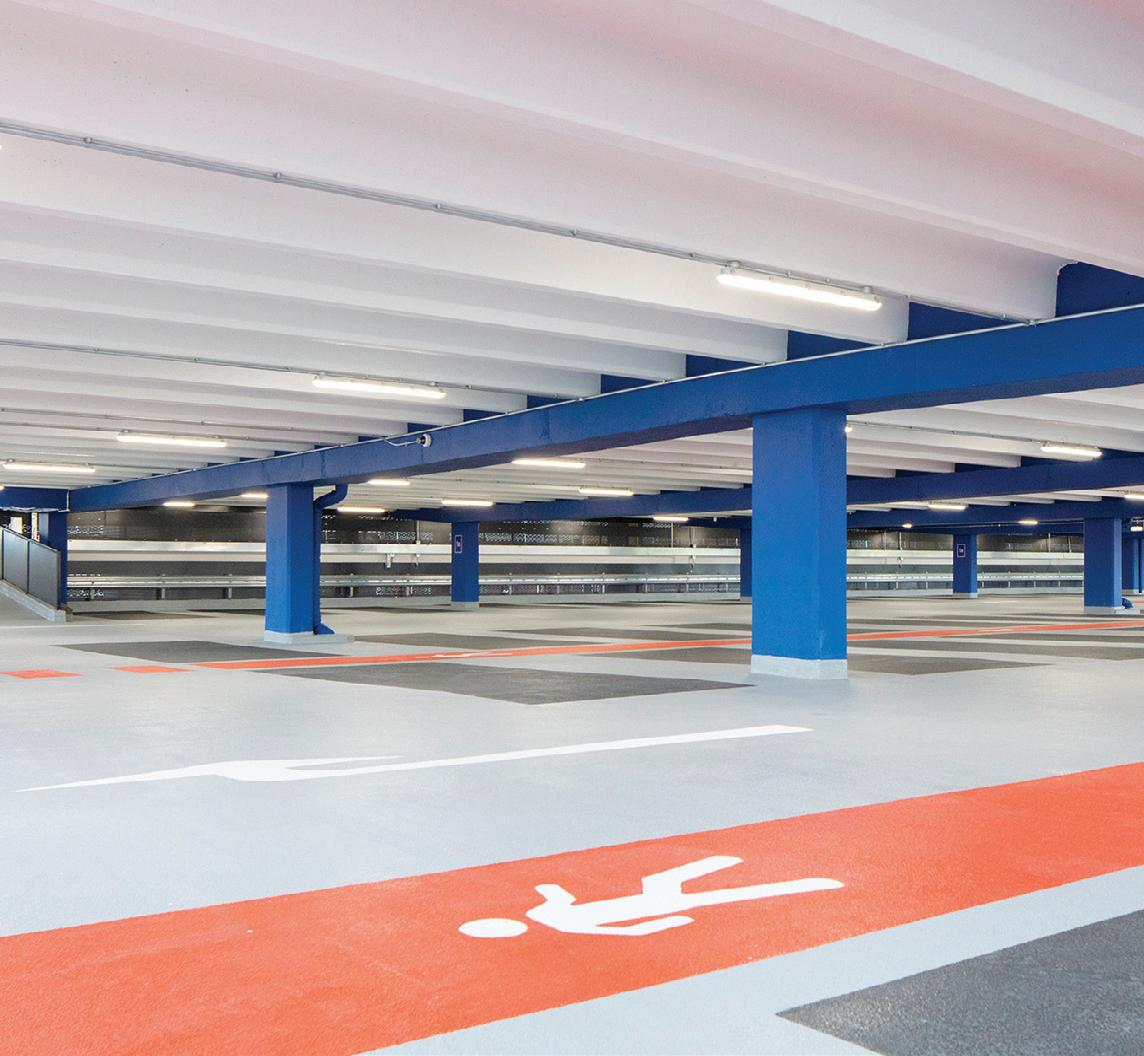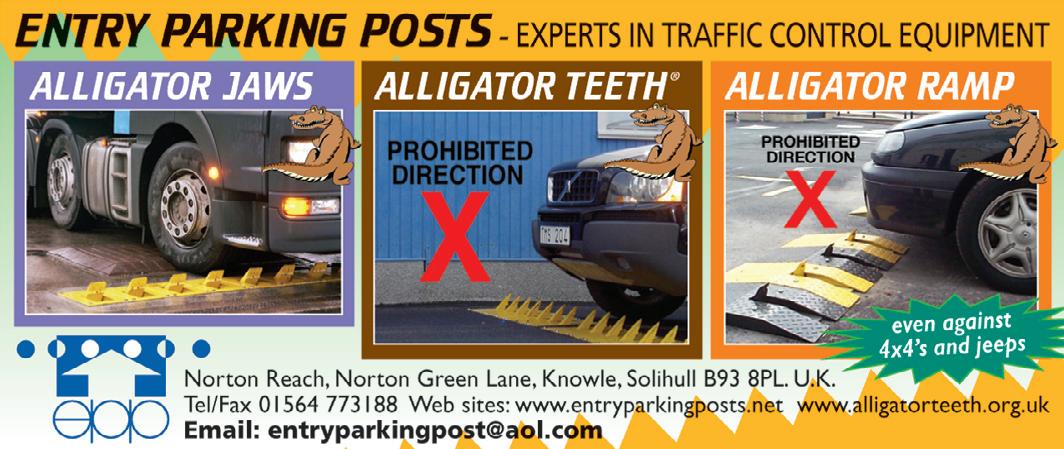T HE ENFORCER
CDER Group’s John Mason calls for action against persistent evaders







Cloned number plates are now being matched with cars of the same make and colour
The use of cloned cars is becoming ever more sophisticated
Whether it is the use of counterfeit and stolen Blue Badges or scams circumventing airport parking charges, the ingenuity some people put into avoiding paying parking fees never ceases to amaze, or more properly, depress me. One fraud that appears to be on the rise is the use of cloned number plates, which break the connection between a vehicle and any penalties issued for its misuse. Cloned plates have been around for many years. Back in the early ’90s one of my brothers was contacted by his insurer to alert him to the fact that a vehicle with the same plates as his first car – a smart, little red Volkswagen Polo – has been used in a robbery on Merseyside. The felons’ vehicle was not a Polo being driven around Hertfordshire, so the police and insurers were content that my brother was not involved.
Fast-forward to now. The cloning of plates is featuring in the national press, with motorists saying they have been sent ANPR-generated parking, bus lane and other penalties for cars that look like theirs even though they were many miles away at the time. Indeed, I have also been contacted by one driver who received penalties from London while he was driving around the West Country.
Press reports and my experiences are anecdotal, but cloning is becoming more sophisticated, with fake plates being matched to cars of the same make, model and colour. This level of sophistication points to the involvement of criminal groups with the ability to record, advertise and sell vehicle registration marks on a black market. It also reveals that there are people willing to buy these details and find ways to have fake plates made, which is an illegal act. It seems likely that the spread of Clean Air Zones schemes, which are monitored by number plate recognition cameras, could create a demand for cloned plates among the unscrupulous, which will see PCNs wrongly sent to innocent people.
Drivers who use fake plates are criminals. Their vehicles will most likely be uninsured, have no MOT and not be taxed, so both drivers and cars should be regarded as dangerous. The seriousness of this offence is underlined by the fact that fines for using counterfeit plates can be as high as £1,000. So let’s be vigilant and support initiatives to weed out this dangerous activity.
Mark Moran Editor





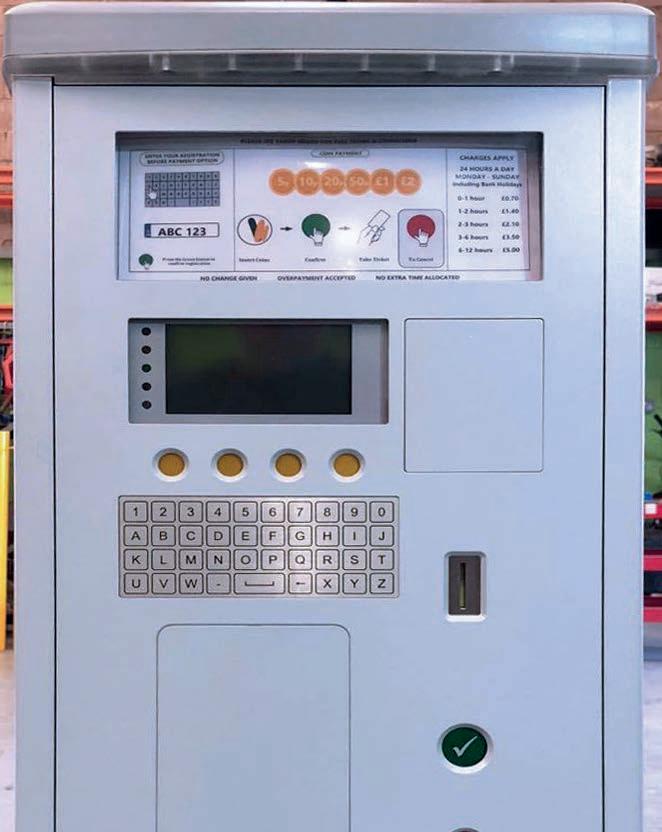












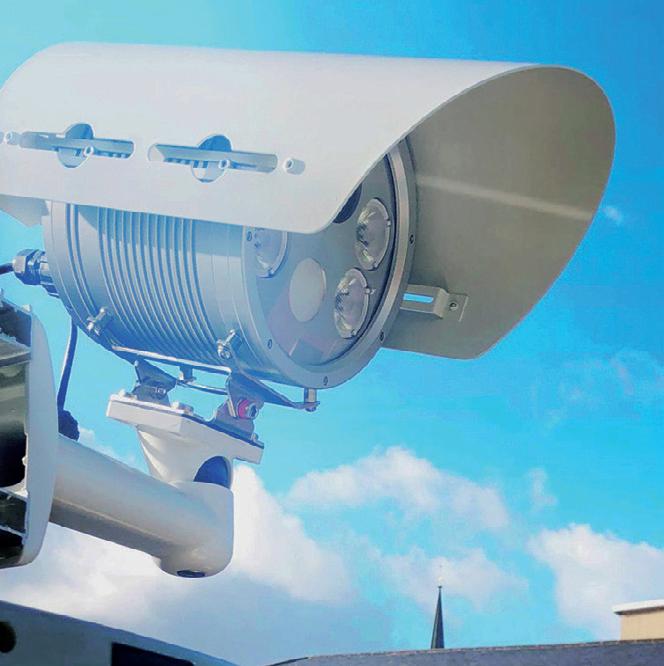






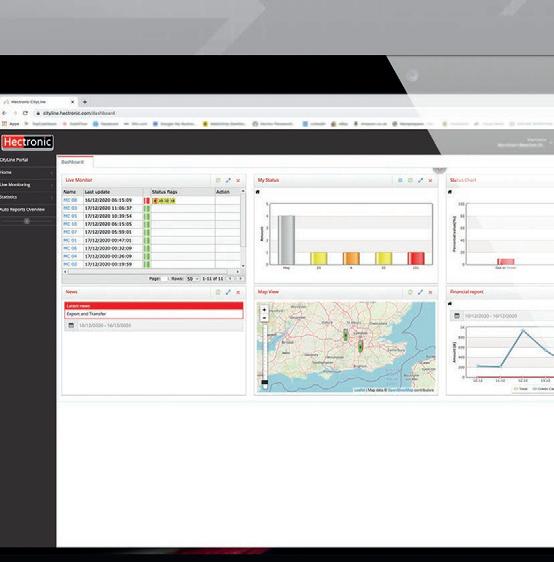





Editorial Managing editor:
Mark Moran
Tel: 020 7091 7871
mark.moran@landor.co.uk
Deputy editor: Deniz Huseyin Tel: 020 7091 7872
deniz.huseyin@landor.co.uk
Editorial director: Peter Stonham
Production and design production@landor.co.uk


Advertising, sponsorship, marketing and exhibition packages

Jason Conboy Tel: 020 7091 7895
jason@landor.co.uk
Subscriptions
Christina Pierre
Tel: 020 7091 7959 subs@landor.co.uk
Accounts
Irina Cocks Tel: 020 7091 7854
irina.cocks@landor.co.uk
Managing Director
Parking

Review was

With local authorities in England soon able to apply for powers to enforce yellow box junctions, the RAC is calling on the government to improve its official design, maintenance and enforcement guidance to councils to avoid thousands of drivers being wrongly fined. From 1 June 2022, councils will be able to apply to enforce moving traffic offences, such as driving through ‘no entry’, ‘no left’ and ‘no right’ turn signs and stopping in yellow boxes which are used to prevent gridlock at junctions. To date, only local authorities in London and Cardiff – and elsewhere the police – have had the power to issue penalty charge notices (PCNs) for these infringements.

While RAC research shows 57% of drivers are generally in favour of yellow box junctions being enforced, the motoring association says it has discovered that many junctions have design flaws which cause drivers to become trapped through no fault of their own, and that some are so poorly maintained that it can be hard to see where the yellow lines start and finish. The concerns were raised during RAC Opinion Poll Panel interviews with 2,597 respondents.
Design flaws flagged up include junctions that have been installed in completely the wrong places, boxes that are larger than they should be and ones where buildings or street furniture
obstruct drivers from seeing where boxes end, making it impossible to assess whether or not there is enough space beyond the junction for their vehicle to fit into. The RAC said the situation can be compounded by crossings and stop lines set back which make it even more difficult for drivers to see whether there is space to make it through the junction in one go as they are further away to start with.
The RAC believes official guidance given in Chapter 5 of the Traffic Signs Manual is generally unsatisfactory as it does not clearly state the specific purpose of box junctions or show how to design them in relation to vehicle movements at junctions, and lacks any information on how they should be maintained and enforced. The RAC learned of the gaps in the official yellow box guidance when it commissioned chartered engineer Sam Wright, who was formerly responsible for the design and approval of yellow boxes on the Transport for London (TfL) road network, to write a report explaining how they are enforced in the capital with a view to highlighting the potential confusion that lies ahead as local authorities begin enforcing them.
Wright said: “The key design principle is that yellow boxes should be no bigger than is necessary to prevent vehicles obstructing through movements. They are not designed for, and serve no purpose in, situations where vehicles are travelling in the same direction. The second main condition is that drivers should have adequate visibility beyond the box to be able to make a clear judgement before entering it. It’s not just that drivers need to see the end of the box, they need to see that there is space beyond the box for their vehicle to fit without any part of it overhanging. In the case of a car that will be 5-6 metres. For larger vehicles, it will
RAC calls on the government to update guidance on yellow box junctions
be up to 15 metres. I think designers should have to take a car out in rush hour to see if they can negotiate the box without stopping, before insisting that others do the same.
“Drivers may also be surprised to hear that there is no legal requirement for authorities to meet this design criteria and it’s simply down to the competence of the enforcing authority.”
In August 2020, the RAC published findings from a Freedom of Information (FOI) request which showed that councils in London and Cardiff have taken in £86m between 2016 and 2019 from a staggering 1.3m penalty charge notices (PCNs). More than £31m was accrued in the financial year 2018/19 from over half-amillion PCNs alone. The RAC believes these figures demonstrate how lucrative box junction enforcement can be for councils as well as how important it is to update the guidance properly when these powers are extended to councils across the rest of England. RAC head of roads policy Nicholas Lyes said: “In the absence of definitive guidance on the design, maintenance and enforcement of box junctions there will be a high degree of confusion among drivers and local authorities which could lead to an avalanche of penalty charge notices being wrongly issued and then having to be appealed. This will inevitably lead to an unnecessarily high number of appeals for local authorities to review, as well as some poor outcomes for drivers.
“We have written to the Department for Transport asking them to update the guidance to make it clear to local authorities what the minimum standard for design and condition of a box junction should be before letting enforcement begin, but they are adamant the present guidance is sufficient. We are worried that failing to update guidance to include the lessons learnt from more than 15 years of enforcement in London will lead to countless wrong fines being issued, no end of unnecessary stress for drivers who feel they have been unfairly treated and thousands of wasted council hours investigating appeals. It’s absolutely crucial that yellow box junctions are enforced fairly and, as things stand, this may not be the case which will mean many drivers will be treated poorly and lose out financially as a result.”
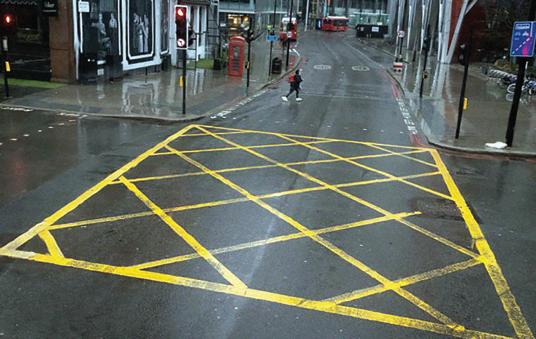
The RAC believes the Traffic Signs Manual Chapter 5: Road Markings section 8.1.2 is extremely unclear and unhelpful stating: “The purpose of a yellow box marking is to mark an area of carriageway conveying the prohibition that a person must not cause a vehicle to enter the box junction so that the vehicle has to stop within the box junction due to the presence of stationary vehicles (S9-7-11).”
The association said Section 8.3.1, which looks at ‘Suitability’, is more helpful, stating: “Experience has shown that the marking improves traffic flow where previously there were delays due to vehicles blocking the junction and impeding the cross flow. At signal-controlled junctions, the queues of traffic left at the end of a green phase have been significantly reduced and there have been marked reductions in injury accidents, especially those involving pedestrians.”
Using information gleaned from Transport for London and Cardiff City Council – where there are already enforcement powers – chartered engineer Sam Wright and the RAC believe a box junction is a traffic control measure designed to prevent gridlock at junctions.
Under the rules of the Highway Code, drivers are not allowed to enter the yellow box unless their exit is clear and there is enough space on the other side of the junction for their car to clear the box completely without stopping. There is an exception – if a driver wants to turn right, they are allowed to enter the box and wait if they are prevented from turning by oncoming traffic, or by other vehicles waiting to turn right. It is perfectly legal to wait on the yellow criss-cross provided the exit road is clear.
The Royal Borough of Kensington and Chelsea is to make 20mph the default speed limit across all its roads in the borough after positive public feedback to pilot schemes. An initial pilot in two wards in 2019 “generally received widescale support, with few objections and several requests for expanding the 20mph speed limit to other streets and areas”, said the council. The results of some early ‘after’ monitoring at ten sites in February 2020 – before the first COVID-19 lockdown – suggested a “very positive speed reduction impact”, the council reported.
The Experimental Traffic Orders (ETO) in the pilot areas were made permanent in November 2020. The council then included a proposal to apply 20mph limits to all remaining borough roads in its Active Travel Plan. Feedback from residents during pilot schemes revealed that drivers did not always notice the smaller 20mph repeater signs, said the council.
“So, we supplemented the signs with 20mph road markings which act as a very clear reminder to drivers of the speed limit and were well received. For this reason, when rolling out the boroughwide 20mph scheme, we focussed on using road markings rather than signs, other than on boundary roads where the speed limit changes from 20mph to 30mph or vice versa.”
Following speed monitoring, consultation and community engagement, the council decided that making 20mph permanent on all roads was the “best option in terms of consistency, streetscape, cost, liveability and road safety”.
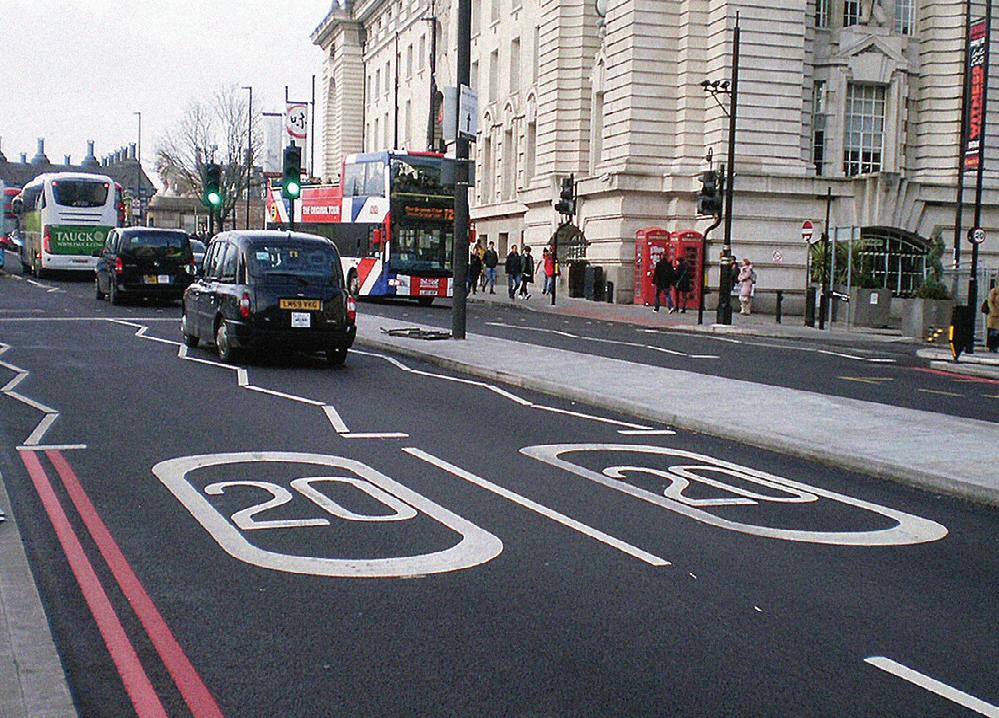
A Kensington and Chelsea spokesperson told Parking Review: “After trialling a 20mph speed limit across all our council-run roads, we have made the policy permanent to make our streets liveable for everyone and encourage more walking and cycling. Since the trial was introduced, we have seen reduced speeds and the speed limits have been widely supported by residents in feedback in the traffic order consultation and from our citizens’ panel.”
Only limited enforcement of the 20mph limits is carried out by the police, using on-street officers, mobile speed cameras and fixed speed cameras. “The police don’t have the resources or view it as a priority compared with targetting other criminal activity,” said the council. However, this could be alleviated through plans by the Met and Transport for London to give enforcement powers to more than 500 police community support officers (PCSOs) in London, with the aim of targetting one million speeding offences a year.
The spokesperson told Parking Review: “Even without much enforcement, the limits have reduced the number of vehicles going above 30mph (i.e. the old speed limit) so it’s a big win there for residents who complain traffic is going too fast.”
Rod King MBE, campaign director for 20’s Plenty for Us, said: “This decision by councillors to make the 20mph limits in Kensington & Chelsea permanent is welcomed. It represents a further step in both the consolidation of 20mph boroughs in London, and also the normalisation of 20mph with significant reductions in speed and support from residents. 20mph is becoming the universal foundation for all communities to make them better places to be.”
20mph becomes default speed limit in Kensington & Chelsea, reports Deniz Huseyin
The Traffic Penalty Tribunal (TPT) has launched an animated video to explain the enforcement and appeals process for civil traffic penalties in a more engaging, accessible way. Available on the tribunal’s website the video seeks to bring to life the experience of appealing to motorists.
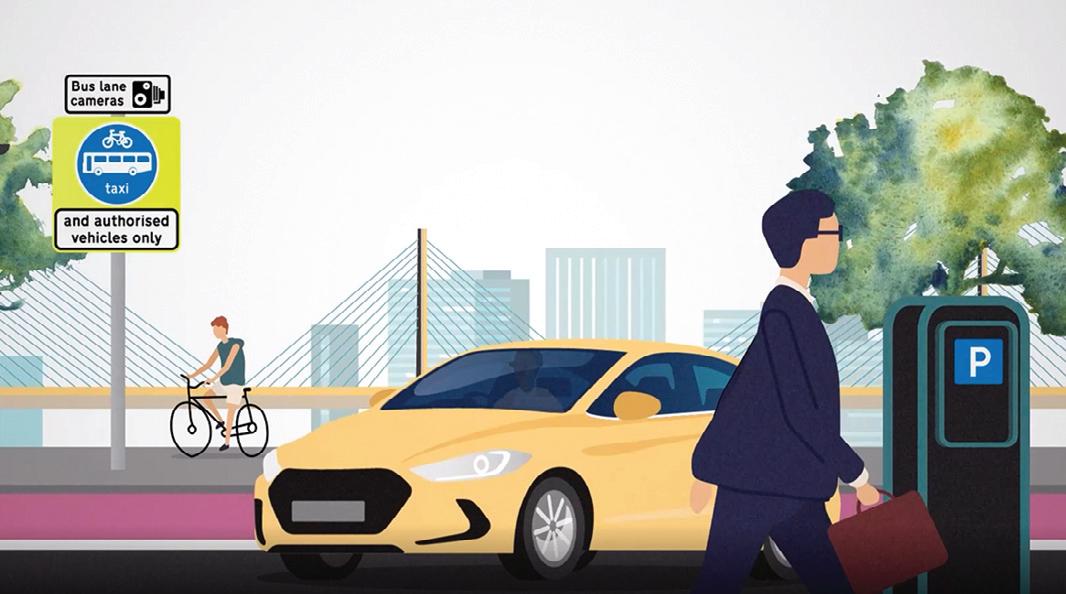
The film continues a focus by the TPT on refining and enhancing the user experience for appellants, based on continual research and feedback. The website has also undergone a complete redevelopment.
The launch of the video comes at a time of significant growth in the TPT’s jurisdictions. The tribunal recently took on the handling of appeals for the growing number of Clean Air Zone (CAZ) schemes and is set to see appeals arising from the commencement of moving traffic enforcement by local authorities in England (outside London), expected later this year. A new version of the video, including specific reference to moving traf-
fic, will be released when the first authorities start to enforce.
The video introduces the different types of penalties that can be appealed to the TPT, while establishing the important context of the civil enforcement pro-
cess that surrounds them.
The core section of the video animates the user experience of appealing online, presenting the different elements of the tribunal’s award-winning digital case management system, from
registration and the possibility of uploading a wide range of evidence types, to the use of instant messaging and Live Chat during the course of an appeal.
Also included is an animated representation of a telephone/ video hearing with an adjudicator, taking place over the Microsoft Teams platform. A further explanatory video focussed solely on the hearings user experience is planned to launch on the website soon, following a detailed research project into this process at the TPT, which is led by chief adjudicator Caroline Sheppard OBE.
Patrick Duckworth, director of Amped Consultancy, who leads the communications function at the TPT, designed and developed the content for the new video. He sees an increasing use of video further deepening and enriching TPT’s long-standing commitment to putting the user at the centre of its service delivery. “Over 80% of all consumer internet traffic in 2022 will be consumed through online video and it is well documented that video content significantly increases retention of information,” said Duckworth.
The TPT undertook a user research project with appellants, authorities and adjudicators that looked at the experience of telephone and video hearings during a tribunal case. While around 90% of all cases at the TPT require no hearing at all, the objectives of the research were to test a series of new processes aimed at:
• allowing those who are able and wish to connect themselves to hearings to do so using the Microsoft Teams platform
• improving the appellant and authority
user experience and communications
• streamlining administrative procedures for scheduling, booking and connecting hearings.

The research project was started with an eye on the likely increased TPT caseloads to come from appeals from Clean Air Zones and moving traffic enforcement in England (outside London), as well an unexpected consequence of the COVID pandemic being that more people were
The North Essex Parking Partnership (NEPP) has launched a new website. A key feature of the website is improved site navigation and usability due to the addition of a search bar function as well as a clearer, user-friendly layout. News and service updates now have individual pages per article, making it easier to find important information. There will also be a new look for the operational and annual reports, which will be hosted on the website to improve usability and accessibility.
The new website, north.parkingpartnership.org, gives people information 24/7, 365 days a year on NEPP’s work to deliver parking services across the area and how to sign up to the cashless parking scheme, MiPermit.

The website also details the steps customers should take if they wish to appeal a penalty charge notice (PCN) they have received.

Users will continue to be able to pay PCNs they have received, through a secure area on the site.
using telephone/video conferencing platforms.
Key findings from the project included:
• over 60% of appellants are now selfconnecting to their hearings

• average reduction of 60% in timescales for scheduling and conducting hearings
• revised suite of communications, including emails from the TPT online appeals system, a new email calendar appointment, ‘How-to’ guide and explainer video
• new online availability tool for adjudicators for scheduling hearings.
It seems logical to believe that parking on a well-lit street at night deters thieves. But the opposite may be true. Fewer cars are broken into at night on roads with part-night lighting (PNL), where street lights are switched off between midnight and 5am, suggests an academic study.
Researchers from the London School of Hygiene & Tropical Medicine (LSHTM) and University College London examined detailed police recorded crime data from Thames Valley Police and data on changes to street lighting from April 2004 to September 2013.

The LANTERNS project found that the rate of thefts from cars at night was halved in streets with PNL compared to the same streets before PNL. Car break-ins decreased from an average of 12 per street per month before PNL to six per street per month after PNL was introduced.
Interestingly, this coincided with a similarly significant 1.5x increase in vehicle crime on nearby streets where the lighting remained on all night, suggesting some criminals are deciding to move to better-lit streets nearby.
However, fewer crimes were ‘displaced’ to these nearby locations, meaning there was an overall net reduction in crime. Thefts of vehicles was also reduced but this was not statistically significant.
The study team found no evidence that lighting changes were associated with changes to the levels of violence, robbery or residential burglary.
Dr Phil Edwards, from LSHTM and LANTERNS project leader, said: “The reason we did this research is because many local authorities in the UK have introduced partnight lighting on quiet, urban residential roads and rural roads, which have very little use after midnight, to save energy costs and reduce carbon emissions.
“However, safety concerns about this policy have been raised. Our previous research showed that switching off street lights at night does not increase crime. This new study suggests switching off street lights between midnight and 6am may actually reduce some types of crime.”
Professor Shane Johnson, director of the Dawes Centre for Future Crime at UCL, and deputy head the Department for Security and Crime Science, said: “Research studies such as this can help us to better understand crime and security issues. The study findings suggest that energy saving street lighting adaptations have not increased crime in the streets studied. This is very encouraging but it is important to note that it does not mean that this will be the case under all conditions, and so changes to lighting should be managed carefully.”
In this study, the team evaluated the impact on crime from changes to street lighting at street level. In contrast to previous studies, the changes to street lighting involved reducing rather than increasing lighting provision.
Three different types of lighting changes – part-night lighting, dimming, and white light – were examined for five crime categories: residential burglary, robbery, vehicle crime and violence.
The team used crime data from Thames Valley Police, together with data on changes to street lighting in the local authorities in Oxfordshire, Reading and West Berkshire. Over the ten-year study period there were 283,275 crimes, of which 79,000 (28%) were vehicle crimes.
After controlling for the underlying longterm and seasonal trends in crime, the team found that theft from vehicles considerably reduced on street segments where street lighting was switched off at midnight.

For street segments with dimmed lighting there was also evidence of a reduction in night-time vehicle crime relative to daytime crime, although the effect was less robust than for PNL. There was no evidence that white lighting was significantly associated with changes in any type of night-time crime examined by the researchers.
Dr Edwards said: “We didn’t set out to find the reasons for the observed changes, but it is possible that when lighting is switched off after midnight, offenders consider that the costs of committing a crime, such as using a torch that could raise suspicion among residents, outweighs the benefits. When lighting is switched off after midnight the streets are likely to be in near darkness, which means that any would-be offenders may find it challenging to see if there are any valuable goods left unsecured in vehicles, so offenders may choose to
move elsewhere to fulfil their intentions.”
Steve Fotios, Professor of Lighting and Visual Perception, University of Sheffield, said: “The public provision of artificial light at night should be based on the best available evidence of its effects on public health and safety. We need to be sure that lighting achieves the goals that we assume it will achieve when following lighting design guidance. The reduction in vehicle crime found by this study is surprising; further empirical research is needed to evaluate optimal light levels for residential streets after dark.”
Peter Harrison, technical director, Institution of Lighting Professionals, said: “The way people use spaces is complex and multifaceted. This report looks at part of the picture and its valuable findings are just one piece of a bigger jigsaw. However, this should not be seen as a ‘one-size-fitsall’ solution. The report also did not mention the impact that lack of lighting had on the elderly and more vulnerable in society –their fear of crime and their reluctance to leave their homes at night.”
The authors acknowledge limitations of the study, including that the findings reported are for only one of the 43 UK police force areas and so the findings may not be generalisable to the national level. Also, for some crime reports the exact time of an offence was unknown, so some vehicle crimes may have occurred either before the lights were switched off, or after they were switched on again.
The LANTERNS project was commissioned by the National Institute for Health Research (NIHR) to assess the impact of street lighting reductions on two important public health outcomes: road traffic injuries and crime. National Institute for Health and Care Research is a United Kingdom government agency which funds research into health and social care.
‘Part-night’ lighting halves car crime but may displace thefts to nearby lit streets, study reveals
A UCL study suggests switching off street lights between midnight and 6am may actually reduce some types of crime
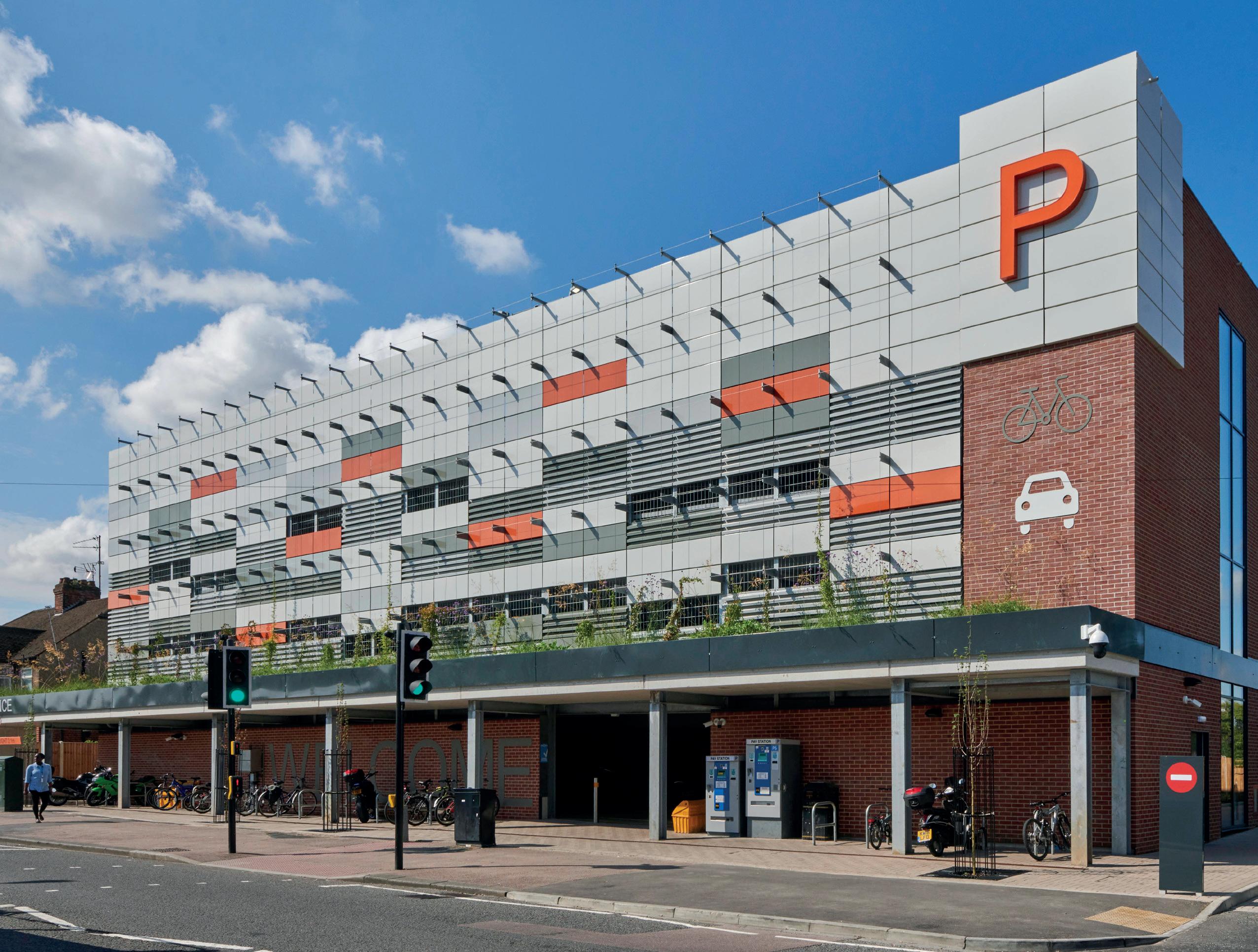



Alfred, London Road and Norton Road car parks and continue their onward journey by bicycle, on foot or by public transport.
rewards to spend at local businesses or donate to charities.
Brighton & Hove City Council is offering drivers the chance to travel in a healthier and more sustainable manner. Three of the South coast resort’s car parks have been branded as Park Active facilities.
Park Active is a British Parking Association (BPA) initiative which aims to help improve health and wellbeing, reduce congestion and carbon emissions, cut down on the cost of travel and provide support for high streets and city centres.
The city council is encouraging people to park in the King
Wayfinding signage has been installed in and around all three to guide people towards popular routes and destinations and all are situated close to BTN BikeShare hubs.
The first 100 BikeShare users can use the promotional code PARKACTIVE22 for £2.20 worth of BTN BikeShare credit. The project is working in collaboration with the council’s Move for Change challenge, which is powered by the BetterPoints app.
People who use the app to log their onward journey from Park Active car parks earn
The high street in the Surrey town of Horley could be made one-way and on-street parking bays removed as part of plans to rejuvenate the town.
Reigate and Banstead Borough Council is consulting about how it can improve the town centre.
Other measures being considered include creating wider pavements, cutting the speed limit to 20mph and installing trees and plants and better seating.
A new drainage and water pumping system would be installed in the subway to the railway station with entrances widened.
New lighting and art are among other ideas to make visiting the area a more attractive experience.
The council gave its initial approval to a £1.5m programme of works in 2020.
This first consultation will be followed by a second later this year when design proposals have been drawn up.
The plans reflect work by Surrey County Council to revive Horley town centre and identify potential projects to improve it.
Plans to build homes on the existing High Street car park also fall under the borough’s Delivering Change programme. A planning application for the project is expected to be submitted this summer.
Cllr Richard Biggs, executive member for planning policy and place delivery, said “We want to invest in Horley town centre so it meets future needs, better suits those that use it and, in turn, boosts confidence in the town.”
Horley Town Council is also supporting the project to “kick-start a new vibrancy”.
Cllr Steve Davis, co-chair of the environment, transport and sustainability committee said: “Park Active is great project and another incentive for people across the city to travel actively and sustainably. We know that, for some people, they may need to use a car for part of their journey into the city.
“But once here, why not use a Park Active car park and walk, cycle or use public transport the rest of the way? Not only is it great for your health and wellbeing, but it will help to reduce congestion around Brighton & Hove and free up space for traders, Blue Badge holders and deliveries.
“Reducing harmful emissions
will also support our goal of becoming a carbon neutral city by 2030, not to mention the health and wellbeing benefits of adding an active travel element to your journey.”
Andrew Pester, BPA chief executive, said: “Park Active is designed to support active travel options that are tailored to the local needs and recognises the key role of effective parking management to help us all go about our daily lives.


“It can improve the health of participants and others living in or visiting the area. It can also mean less time spent queueing in traffic and the opportunity to reach your destination by other means including walking or cycling, as part of a healthier lifestyle choice.”
surveillance, lighting, signage, and cleanliness.
Epping Forest District Council has received Park Marks under the Safer Parking Scheme for 22 car parks.

Park Marks are awarded to facilities that pass a risk assessment conducted by the police and the British Parking Association. The assessments include management and maintenance of the facility, ensuring that there are appropriate levels of
Cllr Sam Kane, portfolio holder for customer and partnerships, said: “Epping Forest District Council is proud to support the Safer Parking Scheme for safer, brighter and cleaner car parks. Ensuring safety of people and their vehicles in our car parks is our priority and we are pleased to provide a safe and welcoming environment for all customers.”
Graham Chapman, BPA area manager, said: “Following consultation between myself and the parking team’s Amanda Hoadley and Gillian Seelig, the council is putting in place arrangements to repaint the fading bay markings in 12 car parks to ensure that they continue to maintain the high standards required for accreditation.”
Seaside resort wants to encourage drivers to walk a bit moreCllr Steve Davis
scrabbling the money back off hard up workers is not the answer. The government must now legislate for free hospital staff parking once and for all.”
Free parking for NHS hospital staff in England introduced during the pandemic ended on 31 March. The Department of Health and Social Care said that the policy was temporary and had been introduced for the duration of the pandemic. It added that running the scheme had cost around £130m over nearly two years.
The fees were waived in March 2020 after 400,000 people signed a petition calling for free parking for NHS workers.
In a written statement to the House of Commons, health secretary Sajid Javid said: “Free parking in hospital car parks for NHS staff introduced during the pandemic will come to an end on March 31. However, over 93% of NHS trusts that charge for car parking have implemented free parking for those in greatest need, including NHS staff working overnight.”
Javid added: “On behalf of the government, I would like to record my thanks to everyone who has worked tirelessly to keep people safe over the last two years and whose efforts have enabled us to move to the next stage of the COVID-19 response.”
The Conservative Party’s 2019 manifesto promised to make parking free for those in greatest need including “disabled people, frequent outpatient attenders and staff working night shifts”.





The Labour Party said: “It
does seem a very odd way to thank NHS staff for their efforts over the pandemic, and in the midst of a cost-of-living crisis to take away free hospital parking at this time.”
Unions have also criticised the move. Rachel Harrison, national officer for the GMB union, said: “Charging the NHS staff who’ve risked their lives during the pandemic to park at work is a sick joke. After the years of Tory cuts NHS trusts are struggling, we know. But
TUC general secretary Frances O’Grady said: “Our amazing NHS key workers put their lives on the line to get us through this pandemic. Scrapping free car parking in the middle of a cost-of-living crisis is a lousy way to repay that service.
“The government should be giving health staff a proper pay rise – not adding to their bills. And it should be funding our NHS properly so that hospitals don’t have to rely on car parks for income.”
In Scotland, charging for parking at most NHS car parks ended in 2008, while the final costs at three hospitals still charging were scrapped in August last year. Parking at all NHS hospitals in Wales has been free since 2018. In Northern Ireland, free parking and free public transport for healthcare workers during the pandemic ended in August last year.
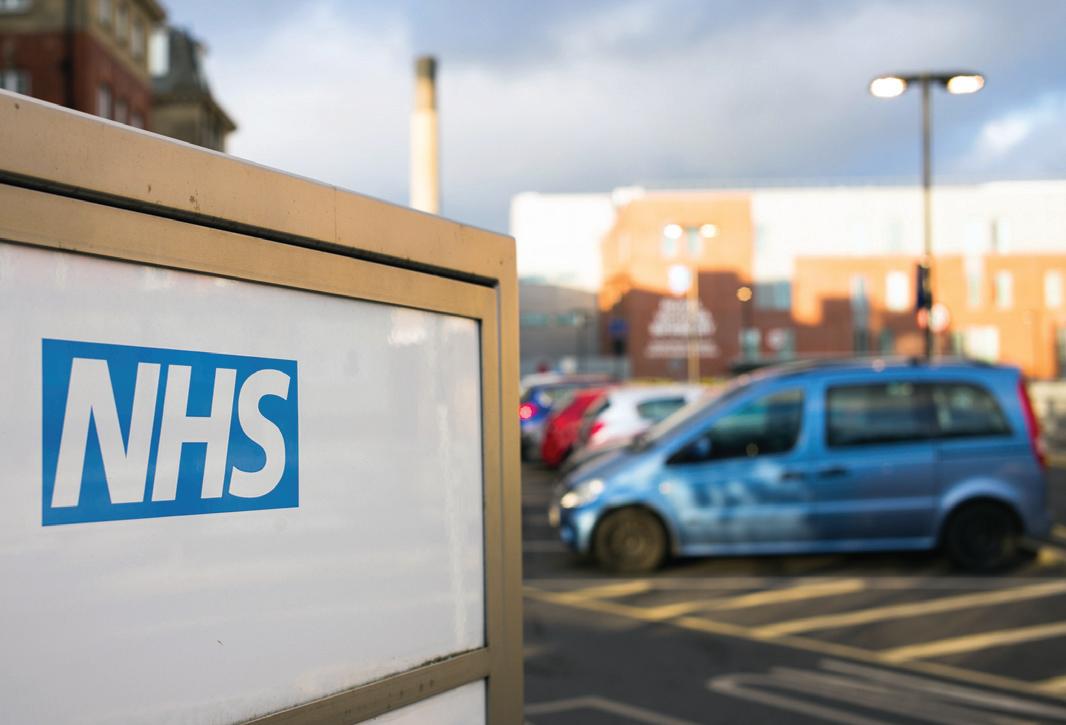
Health secretary Javid says free parking was a pandemic measure









The International Organization for Standardization (ISO) has formally adopted a global parking data specification based on the Alliance for Parking Data Standards (APDS) specifications for vehicle parking and mobility data.
Through its worldwide membership, ISO brings together experts to share knowledge and develop voluntary, consensusbased, market relevant international standards that support innovation and provide solutions to global challenges.
The global ISO network includes a membership of 165 national standards bodies. The ISO utilizes its 803 technical committees to evaluate and approve the development and adoption of new standards. More than 24,000 ISO standards cover almost all aspects of technology and manufacturing, in addition to business, healthcare, transport, and now, parking and mobility.
In April 2019, APDS approached ISO to formally consider the APDS specification for adoption, establishing a global standard for parking data terms and definitions. Over the past three years, parking experts, along with experts from transportation, automotive, and related segments, engaged in discussions and review of the
proposed specification.
Following a formal review and consideration process, the 30 contributing National Standard Bodies participating in ISO’s Intelligent Transport Systems Technical Committee (ISO/TC204) voted strongly in favour of developing and adopting the APDS standard as an ISO Technical Specification. This will be published shortly as ISO TS 5206-1 Intelligent Transport Systems – Parking – Part 1: Core data model.
ISO standards are recognised globally and agreed upon by an international community of experts. Adoption of standards and specifications under the ISO umbrella allows for best practices and action across industries and for a variety of use cases.
Founded by the British Parking Association (BPA), the European Parking Association (EPA), and the International Parking & Mobility Institute
The Department for Transport (DfT) is consulting on amending Traffic Regulation Order (TRO) requirements that affect data sharing, publishing practices and approvals for special event orders.
The DfT is proposing to add a new requirement for traffic authorities to publish standardised, digital and open data about all TROs for anyone to access, use and share. It also wants to require traffic authorities to publish service levels for TRO applicants.
There is a plan to remove a requirement for the Secretary of State of Transport to approve special events orders that: close a road for more than three days; close the
same road on more than one occasion in a calendar year; close roads for filming.
It is proposed to alter the requirement to publish TROs in local newspapers but include other digital media where local newspapers are not available.
Traffic authorities will also be required to publish details of application fees on their websites and review the list of statutory consultees.
The DfT is also asking for views about streamlining the process for installing electric vehicle chargepoints and introducing a unified consent process.
The consultation runs until 17 April 2022.
(IPMI), the Alliance for Parking Data Standards is an independent body supported by a board of directors and a community of affiliates and supporters.
APDS seeks to bring together the parking, transport, and mobility sectors to manage consensus-built, international parking and kerbside management data specifications. These data specifications define a common language based on a set of data concepts and definitions that local authorities, public and private property owners, operators, and service providers can follow to facilitate communication between themselves and with other industries.
The specifications aim to facilitate seamless integration, compatibility and communication between parking and mobility operators, the automotive industry, IT developers, intelligent transport system (ITS) operators, services, map and app providers,

as well as other stakeholders.
Nigel Williams, chair of APDS, offered insight into the importance of this global milestone: “The official adoption of the APDS specifications under the aegis of ISO offers tremendous benefits to the parking, mobility, and logistics sectors. APDS will drive change in those sectors by providing a universal language to facilitate sharing essential data across a multitude of technologies and platforms. We are extremely grateful to our APDS sponsors, volunteer experts, and the parking and mobility community at large for their combined efforts and input have made this achievement possible.”
APDS and IPMI chief executive Shawn Conrad added: “Utilising thousands of hours of industry expertise from leaders around the world, APDS has effectively created a data specification that allows information to flow more freely and to be more understandable across all systems – that will ultimately better our industry and enhance the user and customer experience.”
APDS will release Version 4.0 of the specifications in April 2022. Download the current Version online and subscribe to updates for the official release of Version 4.0 of the global specification for parking and mobility. The ISO technical specification will be available through the ISO website, or National Standards Bodies.
The kerbside is a scarce resource dominated by private vehicle parking but facing new demands for access from active forms of travel and new services such as e-cycles and e-scooters, whilst maintaining freight deliveries and servicing.
The Department for Transport (DfT) has thus commissioned research into the management of the kerbside. The discovery project will determine the user need and barriers for improving kerbside management. It will define user research that represents the various demands for kerbspace now and in the future, build on DfT knowledge and provide expert recommendations to improve
management and digitisation/data integration.
The research will reflect market innovation which is providing new tools towards a digitised kerbside capable of responding dynamically to changing demands. There are new data models such as the Alliance for Parking Data Standards and digital Traffic Regulation Orders (TROs).
The DfT is undertaking user research including the National Parking Platform, EV Chargepoint Data and Digital Traffic Regulation Orders Alpha. While not yet published this work will be made available to Deloitte, which won a £119,000 contract following a tender process.
Living Streets, Sustrans and Arup publish
The UK government needs to stop cars, cycles and e-scooters encroaching on pavement space, says a new report produced by Arup, Living Streets and Sustrans. The Walking For Everyone report makes a series of recommendations that would ensure pavement space is reserved and maintained for people walking and wheeling.
The report is published as the transport industry awaits a government response to the consultation on pavement parking in England and guidance around electric vehicle charging points and for cycle and e-scooter parking, which has resulted in them taking up pavement space.
The report recommends national governments should prohibit pavement parking across the UK, and develop standards where all cycle and e-scooter parking, and electric vehicle charging points are accessible but located on the carriageway.
There is also guidance for local authorities to help make the walking and wheeling environment more accessible and attractive for everyone.
Research from Living Streets has found that 87% of parents with children aged 4 to 11 have had to step into the carriageway because of vehicles parked on the pavement. Forthcoming

research from Sustrans found 72% of disabled people would find fewer cars parked on the pavement useful to walk or wheel more.
Susan Claris, active travel leader at Arup, said: “Taking the report recommendations on board will help the UK meet its transport decarbonisation and levelling up goals. Swapping driving for more sustainable ways to travel is the best way to tackle congestion and air pollution, but we can only expect people to walk and wheel more if our streets enable it.
“We need to prioritise improvement schemes for areas where the provision of local services and public transport is poorer, especially where this coincides with multiple deprivation.”
Stephen Edwards, chief executive of Living Streets said: “Pavement parking is an urgent problem and discriminates
against people walking or wheeling, especially those with young children, older people and people with visual or mobility access requirements. As well as endangering lives, it’s enough to cause many to not leave the house altogether. Outdoor eating areas, advertising boards, parked cycles and scooters can also be problematic and need to be better managed. Pavements are for people, and we need action and guidance to ensure they are accessible for all.”
Sally Copley, executive director for external affairs at Sustrans, said: “While many policy documents often place walking and wheeling at the top of the transport hierarchy, this is not reflected in funding allocations and scheme delivery. As this report demonstrates, a step change is necessary to ensure the environments in which people walk and wheel are as desirable and accessible as possible.”
Living Streets is to get £2.5m funding from the government to support walk to school schemes across England. Funding will support the charity’s Walk to School Outreach project as well as the Modeshift STARS programme, which helps schools and businesses promote active and sustainable modes of travel.
A new Active Travel Academies pilot will also be launched by the charity in partnership with Modeshift and the Bikeability Trust. This will support young people to become Active Travel Ambassadors as well as providing the skills and infrastructure to walk and cycle to school.
The Walk to School Outreach funding for Living Streets will benefit schools in the following local authority areas: Birmingham City Council, Transport for Greater Manchester, Liverpool City Region, West Yorkshire Combined Authority, West
Midlands Combined Authority, South Yorkshire Mayoral Combined Authority, Gateshead, North Tyneside, South Tyneside, Newcastle, Northumberland, Sunderland, Essex, Bournemouth Christchurch and Poole, Warrington, Hampshire, Lancashire and Nottingham.
The Walking for Everyone report is supported by Transport For All.
The campaigns lead Katie Pennick said: “Many disabled people can and want to make more journeys by walking or wheeling, but face barriers in doing so.
“Pavements are often cluttered with bollards, bins, A-boards and lampposts. Sometimes e-scooters and dockless bikes are strewn on the ground, or a car is parked over the pavement.
“Tactile paving, a vital safety feature for blind and visually impaired pedestrians, is often missing, poorly maintained or inconsistent.
“Other times the paving tiles are uneven or bumpy and present a trip hazard, or the pavement is simply too narrow for those with mobility aids or assistance dogs.
“The sensory environment can pose barriers too, with bright colours, loud noises or overcrowding creating discomfort or disorientation.
“Transforming the pedestrian environment to be accessible to disabled people would have a dramatic impact, enabling so many to enjoy positive impacts to mental and physical health, feeling a part of one’s community, and perhaps stumbling across a new favourite spot. That’s what Transport for All campaigns hard to achieve.”
According to Living Streets, the Walk to School Outreach programme has led to 17 million new walking journeys and 1.8 million fewer car miles since 2017, supporting the government’s objective that 55% of primary school children walk to school by 2025.

Transport minister Trudy Harrison said: “Behaviour change outreach programmes are key to giving people the inspiration, information, skills and confidence to enable them to choose to walk, wheel or cycle more of their everyday journeys.”
Stephen Edwards, chief executive, Living Streets said: “Walking rates to primary schools have declined rapidly within a generation. However, in schools where we run our walk to school challenge, the opposite is true. Walking rates in our WOW schools typically increase by 23% and the number of cars at the school gates reduces by 30%, helping to reduce congestion, air pollution and road danger.”
Streets should be open to everyone:WOW mascot Strider at work Cars parked on the footway are a hazard to children LIVING STREETS LIVING STREETS
Christmas period.
Durham County Council has retained NSL as its parking enforcement services partner. The new contract is for five years and five months with an option for a further five years.
NSL has been working for the county since 2000. Under the extended contract, the company will continue to provide enforcement of on-street and off-street parking regulations, including the management of park & ride sites and penalty charge notice (PCN) processing.
NSL also operates Durham’s road user charging scheme, which was the UK’s first congestion charge when it was introduced in October 2002.
Dave Wafer, head of transport and contract services at Durham County Council, said: “It is important that we continue to enforce parking offences across County Durham. Compromising road safety or misusing bays
designated for residents, businesses and people with disabilities can have an impact on people’s lives. We want everyone who lives, works in or visits the county be able to park safely and enjoy their stay, and enforcement is one measure which supports this.”
Over the past 22 years, NSL has helped manage various council buildings and special events including Lumiere, Bishop
Auckland and Seaham food festivals, and Durham City Run,. It has also worked with external events such as Christmas festivals, Durham Miners’ Gala, Kynren Pyromusical and vintage vehicle rallies.

The company also provided community support during the COVID pandemic, including marshalling at household waste recycling centres and helping run food banks over the
NSL project managed the introduction of PayByPhone cashless parking on behalf of Durham County Council to provide more customer payment options. Phone parking was introduced at the height of the pandemic to reduce risk to customers as it eliminated the need to touch multi-use surfaces on pay & display machines.
The deployment proved successful with around 40% of all transactions now made using the PayByPhone service.
Mark Hoskin, chief commercial officer at NSL’s parent Marston Holdings, said: “We are delighted to have been awarded this contract which recognises our ongoing commitment to County Durham and the delivery of social value and green initiatives throughout the next five years.
“Our full portfolio of end-toend transportation and enforcement solutions now includes urban design, CCTV and parking enforcement and notice processing through to debt recovery.”
New deal covers enforcement, P&R and road user chargeDurham NSL
Clean Air Zones are a fundamental part of the air quality solution, but they will not succeed on their own. Solving the air quality crisis requires focus on tackling congestion as well as clean air enforcement.
The UK government’s Clean Air Strategy of 2019 set out to improve air quality through the implementation of Clean Air Zone schemes. Though vital, such schemes will do little to address non-exhaust emissions such as that caused by tyre and break wear, which Emissions Analytics has reported can be 1,000 times worse than exhaust emissions.
While cars will be part of the mobility infrastructure for many years to come, the task before us is to reduce the number of vehicles travelling in urban environments – for which we cannot rely on enforcement alone. We must promote modal shift away from private cars towards other forms of transport by combining enforcement with additional, accessible options. We can do so with the development of ‘mobility hubs.’
On one level, mobility hubs can be seen as an extension of the existing park & ride concept: motorists approaching an urban environment can park their vehicle and access onward mobility options. The mobility hub could be fully integrated with a range of live information systems: road traffic feeds to indicate live congestion and journey times, and real-time air quality to highlight the ongoing issue and harm caused to residents and visitors.




But perhaps the most important integration is with public transport. By integrating the mobility hub with existing passenger information systems, motorists could be informed of the full range of onward journey options, including bus, rail, light rail, ride sharing and more.
In modern public transport journey planners this information can be completely personalised: motorists are guided safely and seamlessly all the way to their destination with a range of options including willingness to walk, accessibility requirements such as step-free locations, and preferred or blocked modes of transport.
Importantly from a health perspective, inclusion of ‘micromobility’ options – bikes, scooters and walking – within the journey planner would present a double benefit: not only promoting low emissions journeys, but also encouraging active travel.
(Clockwise from top left)
1. Stourton park & ride concept for Leeds
2. Cycle parking hub design for Utretch rail station
3. Future mobility hub concept developed by Arup and Go-Ahead
4. Electric vehicle charging hyperhub concept for York

If the description above sounds rather like a mobility as a service (MaaS) network, this is because that is exactly what it is. Interestingly, existing enforcement technology could also support the delivery of a payments system for a mobility hubs/MaaS solution.
Permit solutions can already manage flexible emissions-based permits. An expansion of this technology would enable visitors to a mobility hub to not only purchase a permit to park, complete with electric vehicle charging as required; they could also pay for all onward journeys through the same application, which would serve as a virtual ticket.
Such an approach has powerful potential to drive behavioural change, with variable rates for vehicle emissions and even vehicle sharing: there is no technological reason that we could not offer reduced onward journey rates for those who shared a vehicle to the mobility hub – which could be identified and policed through use of the permit/ticket in onward journeys.

One challenge that must be considered is the allocation of electric vehicle charging points in the mobility hub. Availability of charging points is rarely a problem today, but as the number of electric vehicles increases this will become more of an issue.
Mobility hubs will need to manage access and enforcement of this area, addressing issues such as vehicles using charging spots for longer than required, and policing non-electric vehicles taking up precious charging spaces.
Technology will provide solutions to these challenges, with enhanced ANPR (automatic number plate recognition) systems focussed on specific bays rather than entire car parks; and realtime monitoring tools to proactively direct civil enforcement officers to specific locations.
But more positively, mobility hubs also present an opportunity to rethink how we use parking spaces. For example, why have vehicles sitting idly for drivers to return, when on-site mechanics could use this time to undertake MOTs, servicing and vehicle maintenance?
Such an approach would, of course, eliminate journeys to and from garages; but would also free up time in increasingly busy lives, encourage use of other modes, and deliver a mental wellbeing benefit – something of which most of us are ever more conscious, given the challenges of the past two years.
One of the hardest aspects of any change relates to converting people’s behaviour. We can put the technology in place, but it will be worthless if people don’t use it.
The implementation of mobility hubs will present an opportunity for councils to communicate directly with motorists, whose details will be stored within the permit/ticket system. This channel
can be used to warn drivers of upcoming events and potential travel challenges, and proactively nudge them towards sustainable transport options.
However, the support infrastructure around mobility hubs will also be vital, because if people are to leave their cars outside our towns and cities, they must feel secure in the processes and be fully supported when something is confusing or does not go as expected.
We see an important role for call centres to support the technology. ‘Bot tech’ solutions will help to automate the resolution of common enquiries, but we will also need to be able to put a ‘human face’ on interactions where required.
Specialist call centres, or business processing outsourcing (BPO), will provide the essential support infrastructure that will transform mobility hubs from a daunting new approach into a way of travelling which is at once simple, accessible and natural.
When we first began talking to local authorities about enforcing Clean Air Zones, our message was a simple one: the industry already has technology to meet this requirement; let’s use it.
When thinking about mobility hubs, we believe a similar approach is required. Between enforcement and public transport there is a vast amount of proven, powerful technology which can reduce the number of private, polluting vehicles on the roads.
The next step is to connect these technologies so they work in harmony, changing behaviour and driving towards a common goal.
Mobility hubs represent a precious opportunity to promote technology integration, deliver a transformative effect on the way people move, and provide extra momentum to the clean air and MaaS agendas.
Article produced in partnership with Imperial Civil Enforcement Solutions
Imperial Civil Enforcement Solutions is a UK-based provider of parking, environmental and traffic management systems with over 30 years’ experience in providing fully-integrated business processing and IT solutions to public authorities, universities, hospitals and private enforcement contractors. The Imperial team brings a combination of sector insight, technology skills and the experience of a number of successful service partnerships; providing the capacity, experience and expertise needed to deliver integrated enforcement solutions. www.imperial.co.uk
Mobility hubs present an opportunity for councils to communicate directly with motorists














Editorial
Managing editor:
Mark Moran
Tel: 020 7091 7871
mark.moran@landor.co.uk
Production and design
production@landor.co.uk
Advertising, sponsorship, marketing and exhibition packages
Jason Conboy
Tel: 020 7091 7895 jason@landor.co.uk
Subscriptions
Christina Pierre Tel: 020 7091 7959
subs@landor.co.uk
Accounts
Irina Cocks Tel: 020 7091 7854
irina.cocks@landor.co.uk
Business manager
Rod Fletcher Tel: 0191 280 1410
Printed by: Pensord Tram Road, Pontllanfraith, Blackwood NP12 2YA
Published by: Landor LINKS Ltd, Apollo House, 359 Kennington Lane, London SE11 5QY
© Landor LINKS Ltd 2022
www.landor.co.uk
Registered members of:



The Independent Press Standards Organisation www.ipso.co.uk
The Professional Publishers Association www.ppa.co.uk
A VW ID.Buzz charges up at one of 500 Tesco stores now equipped with free Pod Point terminals that have been installed by the retailer in partnership with Volkswagen
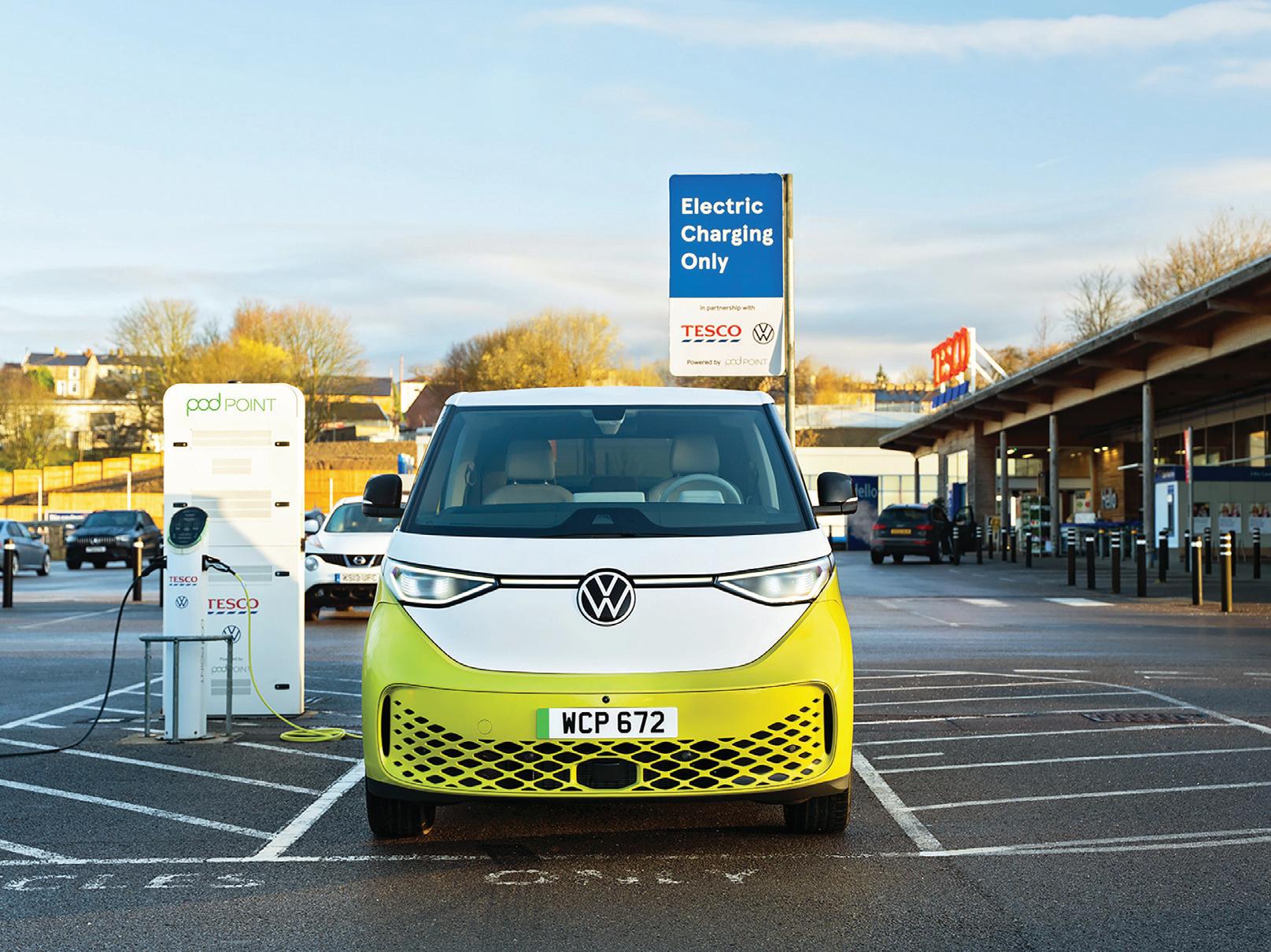
The government’s new Electric Vehicle Infrastructure Strategy aims to achieve tenfold growth in the UK’s public charging infrastructure by 2030 and will introduce legislation to make chargepoints more reliable, accessible and user-friendly.

The Charging Ahead report sets out the government’s plan to have 300,000 public chargepoints available by 2030. This ambition has been widely welcomed by key stakeholders in the sector: chargepoint operators; carmakers; motoring organisations; and energy suppliers.
The government has also been applauded for its plan to mandate contactless payment and to set reliability targets for the chargepoints themselves. The launch of the Local Electric Vehicle Infrastructure (LEVI) Fund is widely seen as a good thing, as is a plan to develop local charging hubs that help drivers who cannot charge at home as they do not have a driveway or garage.
But there remain some notes of caution. For example, there have been calls to reduce VAT on public charging to 5%, bringing it in line with at-home charging. However, moves that reduce tax take are something that the Treasury seems set to resist. And as tax revenue from fossil fuels and sales of internal combustion-engined vehicles decline between now and 2030, policy battles over how far the public sector can, or should, finance the transition to zero-emission seem set to intensify.
Many eyes will thus be looking at how rapidly and deeply the private sector steps into the financing of chargepoint infrastructure.
Mark Moran Editor













The British Standards Institute (BSI) has launched a consultation for a new standard to ensure the accessibility of electric vehicle public charging. The draft standard for accessible charging of electric vehicles will be open for public comment until 4 May 2022.
BSI, in its role as the UK national standards body, is seeking comments from those involved in chargepoint design, manufacture and installation as well as private landowners, local authorities, transport planners, consumer groups and energy providers.
The UK government’s commitment to phase out the sale of new petrol and diesel cars and vans by 2030 will lead to an increase in the use of electric vehicles, which requires a new and significant network of electric vehicle charging infrastructure.
With an estimated 14 million disabled people in the UK, and 2.7 million predicted disabled drivers in ten years’ time, chargepoints will need to be inclusively designed for use by all consumers. The new charging network should be aligned with government policy including Inclusive Mobility.
As this seems set to be first standard of its kind internationally, the BSI
intends to set out the requirements for the provision of accessible public charging for all plug-in vehicles to all potential users and pedestrians, to create an inclusive charging environment for all, including disabled and older people, and people with learning disabilities or neurodiverse conditions.
The focus of the standard, named PAS 1899:2022: Electric vehicles – Accessible charging – Specification, is to agree minimum accessibility standards for all public chargepoints and settings in which more enhanced accessibility can be deployed.
The standard, which is sponsored by the charity Motability and the Office for Zero Emission Vehicles (OZEV), intends to cover: • the location, placement and spacing of charging units within the streetscape and
England has appointed James Court as its first chief executive.
Court worked in the Cabinet Office on the UK’s COP26 transport policy and helped build the Climate Group’s UK Electric Fleets Coalition (UKEFC), representing the UK’s biggest fleet owners. Before that he led work with EV charging companies and manufacturers as director of policy and communications at the renewables

trade body the REA, the Renewable Energy Association.
EVA England’s chair Bridget Phelps said: “James is a passionate advocate for electric vehicles and brings over 15 years of experience working in the environmental, energy and transport worlds.”
James Court said: “There has been a quiet revolution happening on British roads in the past five years, with over 400,000 EVs now
public realm and relative to other infrastructure and/or objects (e.g. placement of charging units relative to individual parking bays, adequate space surrounding the charging unit and vehicle)
• the physical aspects of the environment surrounding fixed charging units (e.g. kerb height, ground type)
• factors to be taken account of in the design and specification of accessible chargepoints and their more immediate surrounding areas (e.g. height of chargepoint, cables and cable management systems, bollard spacing, interface tilt, lighting, colours used, accessibility of language within communications, weight and ease of use of the equipment)
• information, signals and indicators provided.
Nick Fleming, head of transport and mobility
registered, as drivers recognise the convenience and low running costs of electric vehicles. I couldn’t be joining EVA England at a more exciting time, as EV ownership moves into the mainstream and EVs become the obvious choice for people’s next car purchase.”
EVA England is a non-profit community interest company that was established in June 2020 to offer a voice, services and representation to current and prospective electric vehicle drivers. www.evaengland.org.uk
standards at BSI, said: “BSI is excited to be involved in the development of this standard to encourage accessibility considerations in the manufacture, installation and maintenance of EV chargepoints. EV users have a wide range of needs and this PAS can help to improve user experience and ensure the public EV charging network is accessible for all.
“Improving the accessibility of EV charging networks will help to further drive the adoption of EVs, an important step in the decarbonisation of the UK’s transport sector if we are to meet net zero targets by 2050.”
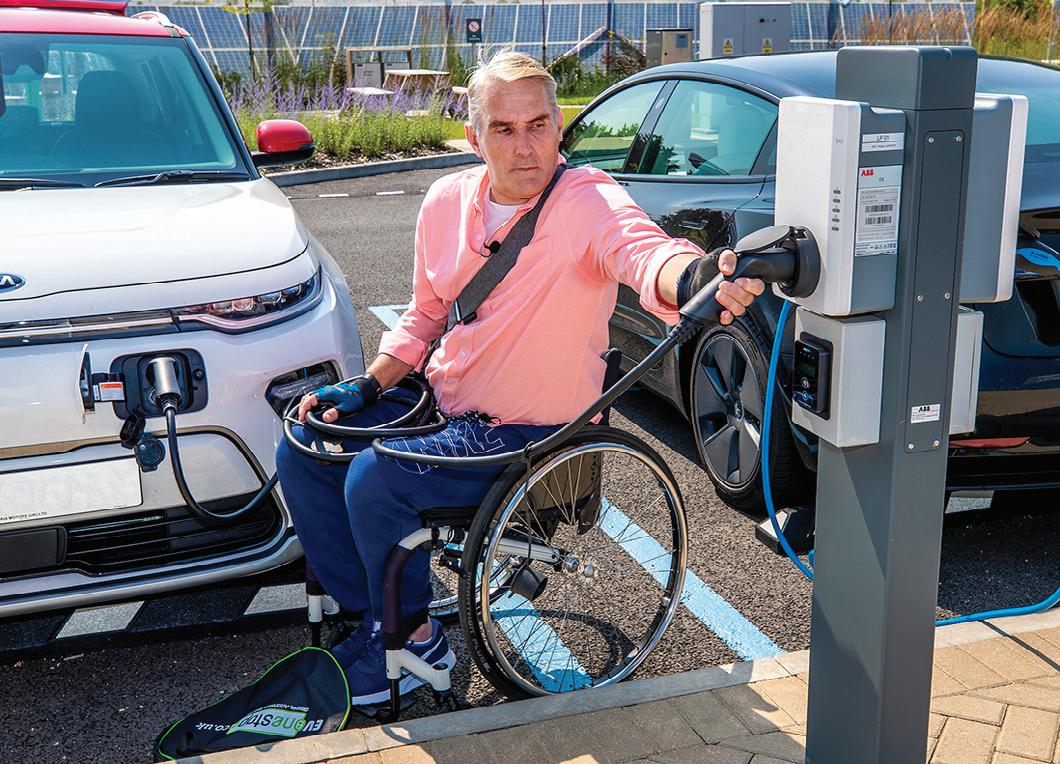
Barry Le Grys, chief executive of Motability, said: “As we transition to net zero, emerging transport options must be made accessible for disabled people right from the very beginning. Our research shows that half of disabled people will be reliant on public EV charging by 2035, yet they face a host of problems using public charging – from confusing instructions on payment units to heavy charging cables and limited space to move around in charging bays. Motability is sponsoring these standards because we believe that they are the only way that manufacturers can develop new infrastructure at pace which is fully accessible for disabled people and fit for the future of travel.”
The standard is due to be published in summer 2022.
Standards body is working with Motability, reports Mark Moran
Only a quarter of local authorities in the UK have published EV transition strategies, despite being encouraged to do so by the UK government and the Local Government Association (LGA), it has been revealed.
Freedom of Information (FOI) requests carried out by the FairCharge campaign show that only 28% of local authorities have published EV transition strategies, with a further 23% in the process of devising a strategy. The FOI requests were sent to all 374 local authorities in England, Scotland, Wales and Northern Ireland on 17 February 2022.
The statutory deadline for responding was 17 March 2022. By this point, 287 councils responded – 76.74% of the total – producing the results outlined above.
The FairCharge campaign, led by motoring journalist Quentin Willson, said its survey reveals the scale of the challenge as the UK government says it intends to
Quentin Willsonmake it mandatory for local authorities to produce strategies.
FairCharge is a grass-roots campaign with over 80,000 supporters that is seeking to ensure the benefits of the EV revolution are available to all. The campaign said the figures were extremely worrying.
Willson stressed the importance of central government taking a more active role in driving public charging provision to ensure the benefits of the EV revolution could be harnessed by all, not just those with access to off-street parking.
Willson said: “The figures revealed from councils in our
Freedom of Information requests are extremely worrying. Business, Energy & Industrial Strategy and Department for Transport say that local authorities are best placed to consider local needs, and this of course is true, but we can see today that without a big role for central government in supporting councils, there is a real chance that much of country will be left behind in terms of public charging infrastructure. Councils clearly need to up their game too, but their needs to be direction and oversight from central government.
“The figures are so
concerning because they mean that many people – such as those without driveways –will be hindered from taking part in the EV revolution. This is simply unfair, and will hold us back in our efforts to decarbonise transport. Our FairCharge campaign is seeking to ensure the benefits of EVs are felt by all. The government should waste no time in placing a statutory duty on local authorities to produce EV transition strategies.”
FairCharge has also been highlighting the other barriers that those without access to off-street residential parking are facing if they are to make the switch to EVs, including leading a push to reduce the 20% VAT rate on public charging so that it is equal to the 5% rate for those who charge at home off-street.
The VAT differential is among one factor that a recent Resolution Foundation report estimated could see those with off-street parking paying £139 a year in fuel costs versus £712 for those without, showing that those without driveways face cost barriers as well as infrastructure barriers.
The government is at risk of failing to deliver the aims of its National Infrastructure Strategy unless it picks up the pace with detailed policy design and implementation, the UK’s official independent infrastructure adviser has warned.
The National Infrastructure Commission says that clear, long-term goals are now in place across most infrastructure areas and gives credit for increased investment – a £100bn commitment over the next three years, alongside an indication of increased spending in the long term.
The commission sets out some key objectives, which include the need to accelerate the roll out of electric vehicle charging points to ensure the 2030 date for the end of the sale of new petrol and diesel cars remains viable. Its annual review of government progress on infrastructure notes that some of its key recommendations have been delivered, including the creation of the UK Infrastructure Bank, and that both gigabit broadband coverage and renewable electricity capacity have continued to increase.
However, the commission is concerned that slow progress being made in other areas poses threats to achieving key objectives at the heart of the
National Infrastructure Strategy. That government document, published in 2020, set out plans for infrastructure to help boost economic growth across all parts of the UK and meet the net zero emissions target by 2050.
The commission states that “some of the strategies government has developed over the last year lack detailed delivery policy, leave key gaps, or simply do not go far enough”.
The commission highlights ten priorities for the year ahead, including the transition to EVs, the need for a comprehensive energy efficiency push to insulate homes, better mobile communications connectivity and investment in passenger transport systems. It assesses recent government activity against five tests: a long-term perspective; clear goals and plans to achieve them; firm funding commitments; a genuine commitment to change; and action on the ground.
The commission highlights the need for a pipeline of mass urban transit schemes beyond the planned development of such a project for West Yorkshire, and a rapid shift away from competitive bidding between councils for short term transport funding pots, towards long term devolved funding
settlements. The commission’s report also flags the need for big decisions on how the net zero transition will be funded, stating: “Ultimately, that will either be taxpayers, consumers, or a combination of both. But ensuring the costs are distributed fairly is critical. Delays to decisions on who pays are now holding up delivering infrastructure, including low carbon heat and energy efficiency. Open and honest conversations, followed by clear decisions, are needed to address this.”
Commission chair Sir John Armitt said: “At a time of significant global volatility alongside concerns about rising living costs, we appreciate that sticking to a long term strategy is not easy. But it is the only way to address the stubbornly difficult problems that will not become any easier or cheaper to solve by delaying action – and the quicker we tackle them, the quicker society and our environment will reap the benefits.”
Sir John pointed to the key role of electrifying road transport, writing: “We need to turbo-charge the rollout of electric vehicle charging points, accelerating the installation of both rapid and on-street charging facilities so that the 2030 date for the end of the sale of new petrol and diesel cars remains viable.”

FairCharge calls on local authorities to ‘up their game’
Geospatial Commission looks at location data
an approach for EV infrastructure roll out and expectations of key stakeholders, the Taking Charge strategy identifies that addressing barriers to data sharing will be important to enable decision making.
location data in the roll-out of EV chargepoint infrastructure. The project will be undertaken by technical specialists FrazerNash Consultancy.
Ten local authorities are involved in the project:
local authorities on this important study, providing our expertise in geospatial data and discovery to enable this important step on the UK’s journey to net zero.”
The UK government has committed to transitioning to EVs in support of its net zero targets. Local authorities will play a crucial role enabling this transition.
The discovery project will support the approach set out in the government’s Electric Vehicle Infrastructure Strategy, published by the Department for Transport, which focusses on enabling the roll-out of a robust EV charging infrastructure network by 2030. Setting out

Dr Steve Unger, commissioner at the Geospatial Commission, said: “Location data will play a key role in planning the UK’s transition to electric vehicles and help make net zero a reality. Through this project, the Geospatial Commission will understand the challenges faced by local authorities who wish to exploit location data. By working together, we will be able to unlock the potential for data-driven innovation in transport.”
The commission’s discovery project includes workshops with 10 local authorities to identify challenges and opportunities for better use of
• Oxfordshire County Council
• City of York Council
• Norfolk County Council
• Greater Manchester Combined Authority
• West Sussex County Council
• Cornwall Council
• Kent County Council
• Leeds City Council
• Wiltshire Council
• Cheshire East Council.
Matthew Perrin, digital services innovation lead, Frazer-Nash Consultancy, said: “Geospatial data is vital to planning, installing and running an effective charging infrastructure for electric vehicles. We are really looking forward to working with the Geospatial Commission and
Cllr Helen Hayden, executive member for infrastructure and climate from Leeds City Council, said: “Over the last five years, Leeds has taken a range of actions, offering free electric van trials, discounted parking and requiring chargepoints in new developments, to accelerate our city’s transition to less polluting vehicles.
“With figures showing that the number of plug-in vehicles in Leeds has doubled over the last year, it is vitally important that we understand how best to expand and improve access to charging infrastructure for drivers on the go or without private parking. We are therefore excited to be part of this timely project.”
The Office for Zero Emission Vehicles (OZEV) has selected a consortium of external partners to support the delivery of its new £450m Local Electric Vehicle Infrastructure Fund.
Part of the Department for Transport and the Department for Business, Energy & Industrial Strategy, OZEV is a team working across government to support the transition to electric vehicles (EVs). These organisations will provide support for the take-up of plug in vehicles, as well as funding to support chargepoint infrastructure across the UK.
OZEV hopes to support these goals with the launch of the Local Electric Vehicle Infrastructure (LEVI) Fund.
The scheme will support the planning and roll out of electric vehicle charging infrastructure across the UK through large scale and commercially sustainable projects that leverage significant private sector investment.
A consortium of British companies is set to collaborate on the realisation of LEVI, combining technical,
commercial and programme management expertise. The consortium comprises the charity Energy Saving Trust, zero emissions consultancy Cenex and design agency PA Consulting.
A collective statement from the LEVI consortium read: “Energy Saving Trust, Cenex and PA Consulting are delighted to have been appointed as the support body
for LEVI, in partnership with OZEV. Together we will encourage large scale thinking amongst councils to help build the local electric vehicle infrastructure needed to support fair access to low carbon travel. We look forward to creating lasting change in the next four years.”
LEVI funding is open to local authorities in England, as well as partnerships or consortiums led by a local authority within England. Applicants for the scheme must be planning an EV charging infrastructure project that supports the transition to EV use in a local area, with a particular focus on provision for those without off-street parking; will provide an improvement in accessible and low-cost EV charging that would not otherwise be met by current or planned EV chargepoint infrastructure; and shows either technical or commercial innovation.
LEVI Fund consortium will dispense £450m to councils
The Geospatial Commission has launched a discovery project to explore how location data can be better utilised to support planning and delivery of electric vehicle chargepoints by local authorities.
£450m to distribute

The UK government plans to spend £1.6bn supporting the UK market reach 300,000 public electric vehicle (EV) chargepoints by 2030. The government’s ambition is to see EV charging become easier and cheaper than refuelling a petrol or diesel car. Taking Charge, the government’s new Electric Vehicle Infrastructure Strategy sets out a plan to improve consumer experience at chargepoints, support people without access to off-street parking and provide fast charging for longer journeys.

New legal requirements will see chargepoint operators have to enable drivers of EVs to pay by contactless, compare charging prices and find nearby chargepoints via apps. There will be particular support for EV drivers without access to off-street parking and on fast
charging for longer journeys.
Prime minister Boris Johnson said: “We’re powering ahead with plans to help British people go electric, with our expanding charging network making journeys easier right across the country. Clean transport isn’t just better for the environment, but is another way we can drive down our dependence on external energy supplies. It will also create new high-skilled jobs for our automotive and energy sectors and ultimately secure more sustainable and affordable motoring for all.”
The government says it will be providing £1.6m of support via Taking Charge. Some £500m will be invested to bring competitively priced public chargepoints to communities across the UK. This includes a £450m Local Electric Vehicle Infrastructure (LEVI) fund, which will boost projects such as EV hubs and on-street charging to serve those without driveways.
A pilot scheme for the LEVI fund will see local authorities bid for a share of £10m in funding, allowing selected areas to work with industry and boost public charging opportunities. The LEVI funding also includes up to £50m to fund staff to work on local challenges and public
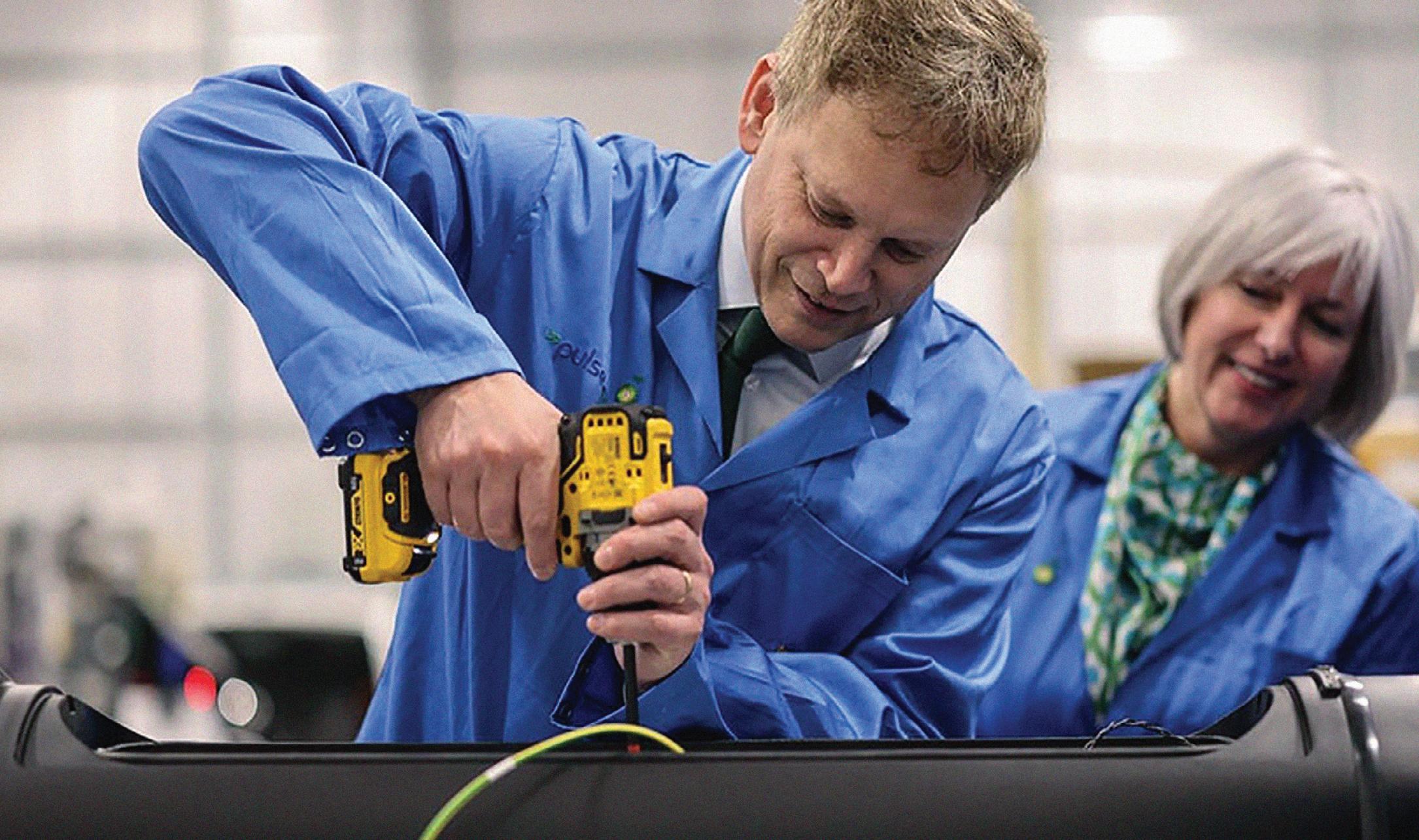
chargepoint planning. The government said this will ensure that any development complements all other zero-emission forms of travel, such as walking and cycling.
The existing £950m Rapid Charging Fund will support the roll-out of at least 6,000 high powered super-fast chargepoints across England’s motorways by 2035.
The promised new funding comes on top of ministers’ pledges to address barriers to the private sector roll-out of chargepoints, such as local councils delaying planning permission and high connection costs.
The government states that chargepoint operators are already committed to installing an additional 15,000 rapid chargepoints across England’s entire road network – a quadrupling of the current offer – and over 100,000 on-street chargepoints by 2025.
New standards and legislation being introduced to improve people’s experience of using public chargepoints. The government is mandating that operators provide real-time data about chargepoints. It wants to ensure that consumers can compare prices and seamlessly pay for their charging using
The Electric Vehicle Infrastructure Strategy has been broadly welcomed, but some organisations have expressed reservations
by mandating binding targets on the rollout of charging infrastructure. He said:”It is essential that infrastructure keeps pace with market demand, or in fact leads demand, to remove any customer fears of ‘charging anxiety’ and accelerates the electrification of Britain’s roads as quickly as possible.”
contactless cards. They will also be able to use apps to find their nearest available chargepoint. The plans will require a 99% reliability rate at rapid chargepoints to give consumers confidence in finding chargepoints that work wherever they travel – helping eradicate so-called ‘range anxiety’.
The government states that, even with recent trends in electricity prices, EVs will still benefit from lower fuel, running and maintenance costs than their petrol and diesel equivalents and the strategy hopes to encourage drivers across the nation to make the switch. And as vehicle production costs continue to fall, the government cites analysts who expect purchase price parity with petrol and diesel cars to be reached well within the 2020s.
Transport secretary Grant Shapps said: “No matter where you live, be that a city centre or rural village, the north, south, east or west of the country, we’re powering up the switch to electric and ensuring no one gets left behind in the process. The scale of the climate challenge ahead of us all is well known and decarbonising transport is at the very heart of our agenda. That’s why we’re ensuring the country is EV-fit for future generations by the end of this decade, revolutionising our charging network and putting the consumer first.”
Alongside the EV strategy, the government is launching an automotive roadmap outlining joint government and industry commitments to achieve the decarbonisation of road transport. This is the first in a series of roadmaps that will be published over the course of the year for each sector of the prime minister’s Ten Point Plan, showcasing how the UK is delivering on green commitments. The roadmap will bring together government policies designed to help and support the automotive sector in the shift towards greener transport and aims to help businesses plan their transition to a zeroemission future.
The government wants the private sector to play a key role in assisting with the switch to electric vehicles. Richard Bartlett, senior vice president at bp pulse, revealed plans to spend £1bn to develop charging infrastructure in the UK. He said: “This £1bn investment is vital to provide the charging infrastructure the UK needs. We’re investing to build a world-class network. This investment allows us to deliver more. More high-speed charging in dedicated hubs and on existing fuel and convenience sites. More home charging services. And crucial enhancements to our digital technology that will make charging fast, easy and reliable.”
Ian Johnston, chief executive of Osprey Charging, said the government’s plan is an important step towards ensuring the UK has the right number of charging points nationwide. “These charging stations simply must be reliable, easy to navigate and importantly, accessible for all,” he said. “There are already many billions of pounds of private investment committed for the deployment of charging infrastructure across the UK. The announcements will allow this funding to provide critical infrastructure to the areas that are as yet underserved – notably motorway service areas and local authority towns and cities across the nation.”
Phil Shadbolt, chief executive at EZ-Charge, welcomed the £1.6bn funding announcement and move to a more open approach to payment. He said: “For too long many chargepoint operators have tried to force customers to use only their networks by making them pay a membership fee or download an app to charge.”
Neil Isaacson, Liberty Charge’s chief executive, believes more can be done to achieve the Prime Minister’s ambition to be the fastest nation in the G7 to decarbonise road transport. He said: “Although this is a really positive step, we believe that there are some additional elements to the strategy that would make it even more powerful. For example, a scrappage scheme to get the worst polluting cars off the road, and a VAT cut to onstreet charging to 5% to bring it in line with off-street charging. We also urgently need further clarification on requirements for how local authorities can access the funds available, if we are to reach 300,000 public EV chargepoints by 2030.”
Mike Hawes, SMMT chief executive, welcomed the announcement, but advised that charging infrastructure must keep pace with the rapid growth of sales of electric vehicles. He said: “The UK already has an enviable and ever-growing rapid charging network, so focus must be given to expanding public on-street and destination charging provision. Every stakeholder will have to play their part in this transition but, if industry and consumers are to have the certainty they need to invest, commensurate and binding targets must be set for infrastructure provision. Deployed nationally and at pace, this expansion would give drivers confidence they will be able to charge as easily as they would refuel, wherever they are.”
Paul Willcox, managing director at Vauxhall, said the manufacturer supports the government’s new strategy but feels it could have gone further
BVRLA, the trade body that represents the vehicle rental, leasing and mobility services sector, believes the strategy will deliver a more reliable experience for businesses. However, it wants to see a similarly comprehensive approach to address the infrastructure needs of fleets. Gerry Keaney, BVRLA chief executive, said: “As a sector that buys and operates more than 50% of EVs in the UK, we would like to see these priorities acknowledged, with more consideration given to appropriate support and interventions. We have particular concerns around chargepoint accessibility for commercial vehicles and believe that the government needs to start planning for HGVcompatible infrastructure as soon as possible.”
RAC head of policy Nicholas Lyes said: “With the electric vehicle revolution already underway, it’s vital the UK’s charging infrastructure is fit for purpose and keeps pace. It’s pleasing that the government recognises the value of mandating contactless payment and will also set ambitious reliability targets on the chargepoints themselves.
“Many current and would-be EV drivers worry that charging units will be out of order when they arrive to charge their vehicles so it is vitally important this is addressed. While the government’s expectation of having 300,000 chargepoints available by 2030 might sound impressive, we are concerned that this is not going to be sufficient with drivers looking to switch to an electric vehicle en-masse ahead of the 2030 ban on the sale of new petrol and diesel cars. Additionally, accessibility standards and assistance for those without smartphone apps should also be part of the overall strategy.”
Edmund King, AA president, said: “As we advance quickly to the 2030 deadline for new zeroemission vehicles, it is vital that we get our charging infrastructure in order. While great progress has been made, there is still much to do to convince drivers on the number, and importantly reliability, of charge posts. To bring confidence to potential electric car drivers we need more, and more reliable and accessible chargepoints as soon as possible.”
The National Infrastructure Commission raised its concerns about the lack of robust delivery and deployment plans for charging infrastructure in its Infrastructure Progress Review 2022. In response to the government strategy, commissioner Bridget Rosewell said: “This is a promising package which tries to tackle the big obstacles and the need for a visible network of rapid chargers alongside better local provision for those without driveways or garages to charge up overnight. Government has now accepted the scale of the challenge and the need to empower local authorities to help ensure chargepoint coverage is accessible and fairly priced for all drivers. We’re shifting into drive mode, and we have a decent map for the road ahead, but we now need to keep our foot down and actually deliver the infrastructure needed to give drivers confidence to make the switch.”
EV Energy Taskforce report explores how UK can deliver the tenfold increase in chargepoints needed to hit government’s 2050 net zero target
The EV Energy Taskforce has set out five key conditions needed to hit the ‘sweet spot’ that meets consumer needs, drives uptake of electric vehicles and provides the right chargepoints in the right places.
The Charging the Future: Drivers for Success 2035 report from the multistakeholder Electric Vehicle Energy Taskforce makes an independent assessment of the scale of the electric vehicle (EV) infrastructure challenge facing industry and government if we are to fulfil the ambition of phasing out internal combustion engine (ICE) cars and vans in time to deliver net zero by 2050.
The government-backed taskforce was convened in 2015 and marks a wideranging collaboration between the UK’s energy, infrastructure and transport industries. The taskforce, which is convened by the Zemo Partnership, has developed a plan to maximise the benefits and minimise the risks of the transition to electric vehicles by focussing on its energyrelated impacts as well as the need for EV users to have access to the right chargepoints in the right places.
The taskforce’s report was unveiled on 31 March, a week after the UK government’s Electric Vehicle Infrastructure Strategy said that a minimum of 300,000 public chargepoints will need to be deployed by 2030.
In support of the government strategy the taskforce has identified key conditions that will create the ‘sweet spot’ for success, driving uptake and enabling an efficient and successful transition to electric vehicles in the UK. To deliver this requires coordinated action from the energy, infrastructure and automotive sectors as well as engagement from EV users.
Through consultation with the widest range of expert stakeholders, the taskforce identified five key ‘enabling conditions’ to ensure the deployment of a charging infrastructure that delivers good value for EV drivers, that is attractive to investors as well as accessible and available enough to meet and build consumers’ confidence about their ability to charge when needed.
The key conditions identified are:
• public charging needs to be built ahead of need to gain consumer confidence
• it is essential that local authorities have the tools, capabilities, powers and resources to ensure integrated energy and transport planning
• public chargepoints have to be used and usable – visible, accessible, connected, secure and interoperable to gain consumer confidence
• smart charging, wherever appropriate, is essential if system cost is to be managed
• informing, educating and protecting EV
users is critical to create the understanding necessary for mass market uptake.
Using a new multi-sector model the taskforce assessed, for the first time, what will be required of the UK’s public charging network to meet the needs of drivers, investors and the energy system. It shows how infrastructure can support the phase out of sales of new internal combustion engine vehicles between 2030-35, and deliver on the transport ambition of Sixth Carbon Budget.
The taskforce has calculated that the UK needs between 253,000 and 661,000 extra chargepoints by 2035 (with a central estimate of 490,000). There are fewer than 30,000 in place today. The model assumes that chargepoints will be built ahead of need to encourage EV uptake while, critically, also allowing operators to gain a return over the lifetime of their installations. However, the report observes that this is a complex market involving a diverse range of stakeholders and one which is not only fast growing, but very immature – like many such markets it carries opportunity, risk and uncertainty.
Philip New, chief executive of the Energy Systems Catapult and the EV Energy Taskforce chair said: “A key challenge in making the UK’s ambition to electrify road transport deliverable, is to
define the type and scale of infrastructure that we’ll need and agree a coherent view of the goal and the order and priority of the steps needed to get us there. With greater certainty, we can build the confidence of those thinking of buying an electric vehicle, investing in a chargepoint or reinforcing the distribution network.
“The EV Energy Taskforce’s latest report covers a significant range of work to meet this challenge. It shows what an infrastructure that addresses consumer needs, integrates into the energy system, is investable and good value, would look like. It also highlights the key enablers required if it is to be delivered and to perform as needed.”

In order to meet the Sixth Carbon Budget and net zero emissions targets and end the sale of ICE vehicles by 2035, 2.5 million battery electric cars will need to be available and sold per year in the UK by 2030; a rate 13 times greater than the record-breaking levels seen in 2021 and consuming as much as 7% of forecast global battery car production. By 2035 electric cars and vans are expected to account for 74% of vehicles on the road.
To provide drivers with the confidence to buy electric vehicles and the means to charge them, near home charging provision will be a critical part of the mix. As many as 50% of public chargepoints will need to provide charging for drivers in homes without dedicated parking. The taskforce believes that local rapid-hub charging could provide a key part of this mix. Higher energy throughput gives such installations the potential to offer better economic returns than on-street charging and be price competitive for users.
En route rapid charging is essential to support long-distance journeys. By 2035 60,000 such chargepoints will be needed along the strategic road network, more than 10 times the number in place today.
The rapid deployment of public chargepoints at this scale implies total UK investment in public chargepoints of £7bn by 2035, most of which the taskforce
700,000 200,000 100,000 0
600,000 500,000 400,000 300,000

Number of chargepoints 20302035
Central case
Increased access to near home charging
On-street Residential only
Shorter journeys
Reduced commuting and other travel
Reduced commuting
Local Rapid hubs only
Lower cost on-street charge points
Source: EV Energy Taskforce
Total number of UK public chargepoints (2030 and 235) and impact of variations: availability to near home charging; journey lengths; overall vehicle mileage; and upfront costs of on-street residential chargepoints
believes can be delivered by the private sector. By 2035, electricity demand from the transport sector is projected to rise to 55 TWh per year by 2035 making up 14% of total UK demand (equivalent to the electricity now consumed by 18 million homes).
Smart charging is identified as being an essential component of an efficient, costeffective and low embedded carbon energy system as it can reduce the requirement for network reinforcement by lowering peak demands. Domestic and slow-speed public chargepoints can also reduce charging prices by 25% or more.
The taskforce’s Charging for Success report was unveiled at a conference in London. Speaking at the launch event, transport minister Trudy Harrison MP said: “The EV Energy Taskforce’s plan comes hot on the heels of our landmark EV Infrastructure Strategy, which sets out our expectation to see around 300,000 chargers across the UK by 2030 – backed by over £1.6bn. The insight of industry is crucial as we roll out the strategy, and I look forward to continuing to work together as we drive towards our cleaner, greener EV future.”
James Court, chief executive of EVA England, said: “Although most EV drivers will charge at home, improving public electric vehicle charging confidence now will pave the road to the rapid adoption of electric vehicles needed over the next decade. Drivers want to easily pay for a charge at convenient and reliable public chargepoints and across chargepoint networks. Real-time information, such as service conditions and availability of chargepoints, are crucial for drivers planning to use the public charging network.”
Nina Skorupska, chief executive at the Association for Renewable Energy and Clean Technology (REA), said: “The work of the EV Energy Taskforce highlights the important role that charging infrastructure has to play in making electric vehicles a viable option for all consumers and businesses. The UK electric vehicle charging network is already growing rapidly and ahead of demand, driven largely by private investment. To continue delivering infrastructure at the rate required – and to ensure equitable access to charging across the country – a combination of public funding and innovative business models will be needed.”
Fintan Slye, executive director at National Grid ESO, said: “Smart charging and vehicle-to-grid provides an opportunity to reduce peak demand, driving down system operation costs and consumers’ bills. This enhanced charging flexibility also allows EVs to charge when more renewable energy is on the system, reducing the need for fossil fuel generation and helping us to achieve our plans to run a 100% zero-carbon grid.”
Andy Eastlake, Zemo Partnership’s chief executive and deputy chair of the EV Energy Taskforce, said: “The development of a multi-stakeholder coordinated view on what is needed to deliver the electric vehicle charging revolution in the UK over the next decade is vital in aligning activity across sectors. Zemo Partnership has been working to decarbonise UK road transport since 2003. We’re proud of our role in convening the EV Energy Taskforce and bringing the broadest range of stakeholders together to tackle the electrification of transport, ensuring the electricity system and the charging infrastructure is ready for the mass take-up of EVs.”

BP has announced new plans to invest £1bn in electric vehicle charging in the UK. Its EV charging business bp pulse intends to make the investment over the next 10 years helping to meet the UK’s fast-growing demand for EV charging and support the country’s transition to low carbon transportation for both consumers and fleets.

The investment will allow bp pulse to deliver more rapid and ultra-fast chargers in key locations, expand fleet products and services, and launch new home charge digital products and services.
BP claims the investment will enable bp pulse to:
• approximately triple the number of public charging points in its UK network
• accelerate the roll out of
300kW and 150kW ultra-fast charging points that are able to provide EV drivers up to 100 miles of range in around 10 minutes of charging, depending on the model of electric vehicle
• upgrade its current EV charging technology across its public charging network to improve reliability
• support hundreds of new jobs in the UK.
Richard Bartlett, senior vice president, bp pulse, said: “This £1bn investment is vital to provide the charging infrastructure the UK needs. We’re investing to build a world-class network. This investment allows us to deliver more high-speed charging in dedicated hubs and on existing fuel and convenience sites.”
The announcement came as transport secretary Grant
Shapps visited bp pulse’s UK headquarters for network expansion and customer care and operational centre in Milton Keynes to unveil the government’s EV Infrastructure Strategy.
Shapps said: “I am delighted that bp pulse is supporting the transition to cleaner vehicles as we accelerate towards our net zero ambitions and boost green jobs opportunities right across the UK. Convenient, reliable and affordable charging is key to our green revolution.
“This step comes alongside the government’s publication of its landmark EV Infrastructure Strategy, showcasing the huge commitment of both the public and private sector in the nationwide switch to electric vehicles.
“EVs benefit from lower fuel, running and maintenance costs than their petrol and diesel equivalents and the strategy hopes to encourage drivers across the nation to make the switch.”
Over 700 fast EV chargers will be installed by Uber on the streets of Newham, Brent and Redbridge, boosting London’s overall charging network by over 7%.
The new chargers are the result of a £5m investment from ride-hailing app Uber, which is working in collaboration with each borough to determine where chargers should be installed. The on-street charging points will improve access to charging for those without driveways or home chargers.
The chargers will be Uber branded and available for everyone to use.
Jamie Heywood, Uber general manager for Northern and Eastern Europe, said: “Drivers often tell me that being able to access reliable charging near their homes is critical to their decision to switch to an electric vehicle. By targeting investment where it is most needed, we are confident that thousands more drivers will make the switch to electric, allowing them to benefit from lower running costs and higher earnings on Uber.”
More than 5,000 EVs are currently on the app in London, driving over one million electric miles per week. Uber said it is on track to more than
double this number by the end of the year and to become an all-electric platform in the capital by 2025.
Professional ride-hailing drivers are proving to be early mass adopters of EVs, with more than 90% of new vehicles joining the Uber app being fully electric, compared to 11.6% of new vehicles in the mass market during 2021.
Imtiaz Elahi, an EV driver from Newham who drives with Uber, said: “I’m seeing more and more drivers change to electric vehicles and I even convinced a few to make the switch myself. But with the uptake of EVs
increasing, the number of chargers on the street needs to keep up. If we want drivers to keep converting to EV we need to improve access to chargers in all London boroughs as well as across the country.”
The concentration of EV chargers is currently highest in central and west London, with over a quarter of chargers in Westminster, Kensington & Chelsea, and Hammersmith & Fulham. However, with many drivers living in boroughs such as Brent, Newham and Redbridge, there is significant demand for more charging points in these parts of London.
Cllr Krupa Sheth, cabinet member for environment at Brent Council, said: “These charging points will provide greater accessibility for residents who do not have off-street parking, thus helping us promote the use of zero-emission vehicles.”
Rokhsana Fiaz, Mayor of Newham, said: “The agreement with Uber brings funding into Newham to help make charging more available, which can help support the jobs of thousands of Newham-based drivers. We promised to increase our EV charging points and this will help create a bigger network of chargers that all our residents can use and benefit from.”
Cllr Jas Athwal, leader of Redbridge Council, said: “We’re on a mission to expand Redbridge’s on-street electric vehicle charging network to make it easier for local people to switch to an electric vehicle, helping to cut air pollution and tackle climate change in the process.”
Later this year Uber plans to expand its EV-only Uber Green option from Zone One to the whole of London. This will mean riders will be able to request an EV from anywhere in the city for the same price as an UberX. Drivers will earn 13% more when taking trips on Uber Green.

Investment will triple number of bp pulse chargepointsUber is working with the boroughs of Brent, Newham and Redbridge BP wants to increase number of ultra-fast charging points

Power bank on wheels enables EV drivers to charge wherever they park

ZipCharge has won a British Engineering Excellence Award for its Go portable electric vehicle charger.
The R&D Project of the Year trophy was presented in recognition of ZipCharge’s R&D programme and putting the charger through meticulous automotive industry car development processes and standard trials to ensure it is ready for market in early 2023.
The Go portable EV charger is now advancing to validation prototype (VP) stage with designs released for manufacture and hardware testing well underway.
The ZipCharge Go removes a common barrier to EV ownership by bringing the possibility of home charging to anyone who cannot currently plug-in at their house. In the UK alone, 8.5 million or 40% of car-owning

households are without designated or off-street parking. Elsewhere, this figure reaches 60% for example in Italy, Spain, Hong Kong, Singapore and South Korea and in major cities in the USA, China and India.
ZipCharge co-founder Richie Sibal said: “Winning this award is terrific recognition of the hard work and dedication the team has invested in making the ZipCharge Go a portable EV charger you can use every day, whatever the weather and in
any location. Our customers will expect their EV power bank to be as robust and hardwearing as their vehicle, so we have implemented exhaustive automotive industry testing standards to the unit, the electronics and the software. We’re highly confident it will work perfectly wherever they park their EVs.”
ZipCharge co-founder Jonathan Carrier added: “ZipCharge is a great example of British engineering and innovation. Winning this award underlines the UK’s
position as leaders at the forefront of electrification. The UK is globally recognised as engineering some of the best EVs in the world, from the Nissan Leaf to the LEVC Taxi. Now our EV charging products are engineered to the same exacting quality.”
The British Engineering Excellence Awards have been running since 2009 to champion and celebrate design and innovation within the UK.
Philippa Oldham, chair of the awards and stakeholder engagement director at the Advanced Propulsion Centre, said: “ZipCharge took an innovative approach to develop a product that addresses a real need in the fast-growing EV market. It’s a simple concept, but with quite complex technical challenges and the judges were impressed with how they managed this. The value and use case for a portable EV charger is evident,with the potential to break down barriers to EV ownership and I look forward to seeing this product come to market.”
APT Skidata has launched a system that allows electric vehicle (EV) drivers to pay for parking and re-charging services in one transaction. Known as Charge, the solution combines the company’s ePlug charging stations with its Parking.Logic management system to enable customers to pay for parking and charging at the same time through the standard pay machine or at the exit.
Charge enables EV drivers to pay without the need for an additional app or payment terminal. “The demand for EVs and chargers has surged over the last four years, with a 66% increase in the number of EVs on the road since 2019,” said Steve Murphy, managing director of APT Skidata. “While there has been a rise in the number of public EV chargers, with 22,000 available, the number is limited when compared to the 1 million EVs on the road, resulting in a ratio of one charger per 43 EVs.
“Drivers readily complain that charging points are often inconveniently sited, there are too many networks, and there are already too many apps.”
Murphy said that with up to 20 million EVs expected on roads by 2030, systems such as Charge will help fill a logical gap.
“Car parks provide the ideal opportunity to charge your EV, and despite having all this space to add chargepoints, very little space is currently given over to EV charging,” he said.
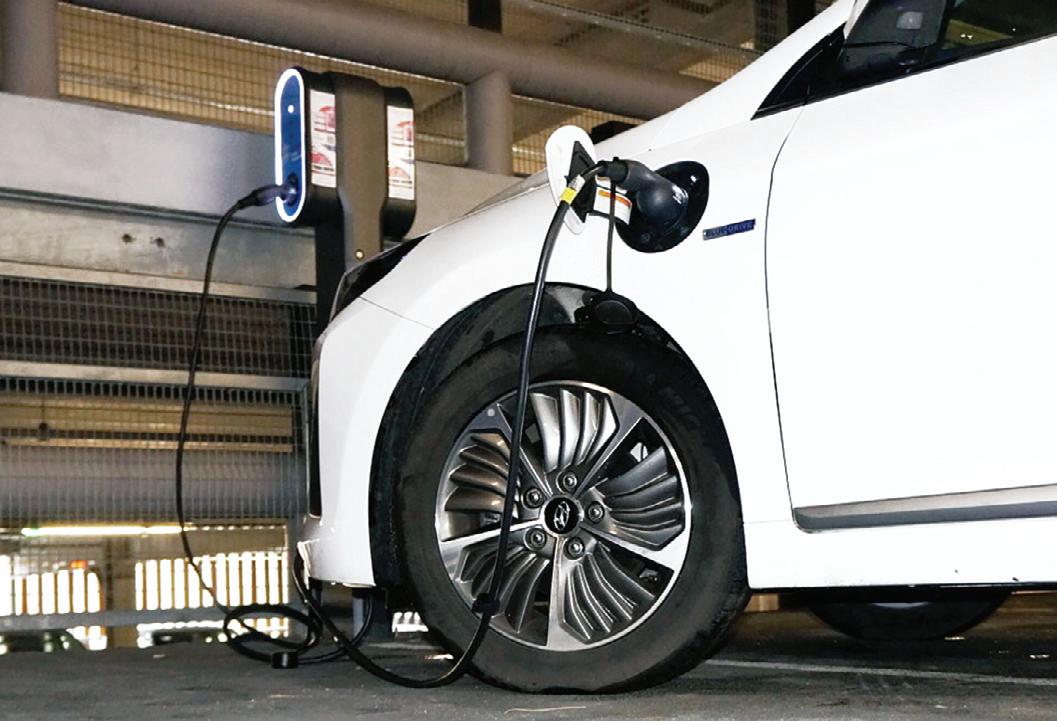
“One of the barriers is that there has been no true integration between the parking systems but thanks to Charge this is now possible. Charge provides a better, more convenient solution to the customer, while helping car park operators to make

their site a destination with all the benefits this brings to local communities and none of the hassle of any additional third-party integrations. So, if you want to add EV charging to your site it does not have to be complicated. In fact, if you know how to use Parking.Logic, then you already know how to manage EV charging.”
APT Skidata’s ePlug chargepoints are available as either wall or pedestal mounted and come with a standard type two connector to a maximum of 22kW. Each ePlug operates alongside APT Skidata’s eSelector user interface, greeting users with a comprehensive charging guide and instructions.
Customers can check out using a 2D barcode, QR code, or with their licence plate when an automatic number plate recognition (ANPR) system is installed.
Murphy said the charging process is as simple as parking. “Customers simply arrive, plug in, identify themselves, and go about their business while their vehicle charges,” he said. “On their return, they pay for their parking and charging in one single transaction, unplug their vehicle and they’re on their way. It couldn’t be easier. We’re making EV charging available to everyone, in places where everyone goes.”
Flowbird Smart City UK has completed its first local authority electric vehicle (EV) chargepoint pilot project for Wokingham Borough Council. The infrastructure upgrade will help meet demand for the growing use of EVs across the Berkshire borough.
EV drivers in Wokingham can access Flowbird Smart City UK’s app which charges for both the parking session and the kW consumed, allowing the council to offer combined or separate parking and charging rates. The app can be accessed by registered users or guests.
Flowbird Smart City UK’s Cale Web Terminal units can also be linked directly to the chargepoints. The company claims this is the first time a pay & display terminal will provide options for everyday park & charge users.
Danny Hassett, Flowbird’s managing director Smart City
UK, says: “Wokingham’s new EV connectivity will be innovative, as linking a payment terminal to a chargepoint is a new development in parking and charging.
“As EVs move from early adopters to the mainstream, people need simple ways to
both park and charge and the option to pay in whichever ways suits them. And councils need ways to price both parking and charging separately or as a bundle. This solution will meet both needs for the first time.
“The system is backed up with a 24/7 support line to
help end-users troubleshoot unforeseen operational issues – offering a solution to out-ofservice terminals that frustrates users and deters EV uptake.”
The new EV chargepoints are located in three busy parking sites across the borough – Dinton Pastures Country Park, Carnival Pool MSCP and Shute End Eastern car parks. All are threephased, which give out a 22kWh charge, and support all new EVs that utilise a standard AC charger.
Geoff Hislop, parking manager, highways and transport, at Wokingham Borough Council, said: “We chose Flowbird Smart City UK for this trial as their solutions are both cutting-edge and reliable. We are confident we now have infrastructure that will support the demand for electric vehicle use now and in the future.”
Organised by: Headline Sponsor:



The idea of providing a concentration of mobility services at one place is emerging as a way of creating sustainable public transport systems.
When reimagined as mobility hubs, car parks are no longer just places to store vehicles. Instead they become positive places that offer co-located services such as electric vehicle (EV) charging and shared mobility services.
Mobility hubs also represent the next step in the evolution of park & ride services, which will become genuine interchanges where people can switch from private cars to buses, trains, cycles and walking.
EV hubs offer drivers access to chargepoints in car parks at destinations such as shopping centres or in service area style facilities on major roads. The parallel emergence of service hubs is seeing other car parks acting as bases for logistics services and a range of activities such as ‘dark kitchens’ and ‘dark stores’.
This one-day conference will see speakers and expert panels explore the design, implementation and operation of mobility, EV and service hubs.
Confirmed speakers and panellists taking part in Mobility Hubs 2022 include:

l Mihir Benison, Arup
l Matthew Clark, Steer
l Keith Fisken, SEStran
l Rob Grocott, Mobilize Power Solutions
l Sam Hunn, Fonix
l Fiona Jenkins, Steer
l Habib Khan, Meristem Design
l James Lancaster, Enterprise Rent-a-Car


l Matthew Ledbury, CoMoUK

l Jennie Martin, ITS (UK)
l Paul Moorby OBE, Chipside
l Tina Mould, Oxford City Council
l Grace Packard, Mobility Transport Expert
l Fiona Petch, Fatkin
l Mark Potter, Potter Church & Holmes Architects
More speakers to be confirmed soon
www.mobilityhubs.uk

Confirmed exhibitors include:
The event’s exhibition provides an excellent opportunity to showcase your systems and services. To find out how your organisation can be part of the day contact Jason Conboy on: jason.conboy@landor.co.uk

First Delegate £225 + VAT Additional Delegate £150 + VAT
Supported by:Mobile payments provider PayByPhone has unveiled a new international and UK leadership structure as the company shifts away from its regional organisation to a global approach.
The new global structure, which came into effect on 1 April 2022, focusses on supporting the company’s three key customer groups: clients, such as cities, local authorities and parking operators; corporate, including fleets and businesses; and consumers, the drivers who use PayByPhone’s services.
Three experienced PayByPhone leaders will be stepping up to lead each of these areas, with product and development teams also organised to support this structure.
The company hopes this dedicated approach will underpin current strong 60%
year-over-year growth and ambitious targets, while ensuring operational continuity across all areas of business.
PayByPhone chief executive Andy Gruber said: “Moving to a global, customer-focussed organisation will allow our customer groups to benefit from dedicated teams and a more tailored approach to their distinct requirements. We know that our cities and parking operators, our corporate customers and our 50 million app users all have specific needs, and we want to reflect this in our global organisation. This new global structure will guarantee that each of our customer groups can continue to enjoy our services and concentrate on what matters most to them.”
PayByPhone is a wholly-owned subsidiary of Volkswagen Financial Services.
The new global structure sees Jonny Combe, who has been UK chief executive since November 2018, promoted to lead the global corporate division as CEO corporate.
Combe will oversee a team across North America, Europe and the UK as PayByPhone looks to expand its fleet business globally with the recently launched PayByPhone Business. This is a solution designed to simplify parking for fleet managers and companies with on-the-go workforces.
Since its launch in 2021, PayByPhone Business has grown more than 250%, helping to give businesses a much-needed solution to manage complex fleet parking issues and to save precious time for both drivers and fleet managers.
Combe said: “I am delighted at the opportunity ahead of me. Our ethos is built on the premise that we are here to simplify the journey for our customers. Nowhere is that more evident than with our fleet customers.”
Roamy Valera, a 30-year veteran in the industry, becomes chief client officer in charge of PayByPhone’s more than 1,300 clients globally. His goal will be to build upon the company’s recent expansion –



client numbers increased by 20% over the course of 2021.
One global client team, focussing on expansion and client success, will ensure not only more places for drivers to park across the globe, but also enhanced experiences for clients. Valera was previously PayByPhone’s chief executive of North America.
Ryan St Hilaire, PayByPhone’s vice president, product, will be responsible for the global consumer division in addition to overseeing all product work. He will focus on the customer experience and ensuring that PayByPhone continues to simplify the journey for the motorist in more than 1,200 cities around the world. Leading design, product marketing and product management teams, St Hilaire will look after the needs of PayByPhone’s quarterly active users, uncovering and building the features and services that best support their journeys.
Valera, Combe and St Hilaire will all report directly to Gruber.
With Combe’s promotion, Anthony Cashel, who was marketing and operations director and has been with PayByPhone since October 2017, is promoted to the role of UK managing director.

Cashel will oversee all day-to-day business matters, safeguard the company culture and ensure the engagement of all staff in the UK. Working alongside his leadership team, he will develop, implement and advance the business’ strategic objectives as it works to meet growth targets.
Cashel said: “This is an exciting time for PayByPhone as we continue to grow and to develop solutions and benefits for our clients and customers. Leading a mature, competitive market like the UK, while at the same focussing our energies on continuous improvement and growth, is going to be an exciting opportunity, and one that I will relish.”
Imperial Civil Enforcement Solutions has made two key management appointments.
David Wearmouth joins the firm as commercial manager and Jenni Brown has been appointed as operations manager
Wearmouth has more than 20 years’ experience at senior management level. Most recently he worked with Videalert as strategic accounts manager, and has also worked for Flowbird Transport Intelligence and Conduent.

Having worked within both entrepreneurial and corporate environments in the transport industry, he has acquired knowledge of a range of approaches to solving business challenges and delivering for customers.
Wearmouth said: “Having worked in the civil enforcement
market since 2006 I have been aware of Imperial and had great respect for the team, the quality of their solutions and longstanding position as a market leader in this sector.
Ashley Bijster, managing director at Imperial, said: “We are so excited to have Dave as part of the Imperial team. He has a wealth of experience in the enforcement business and

his appointment is a significant stepping-stone towards us being able to achieve our ambitious plans for 2022 and beyond.”
Imperial has also appointed Jenni Brown as its operations manager, a role which will see her work with major clients to help take the business onto its next stage of development.

With 19 years of experience in enforcement and client-based
environments Brown’s appointment will enhance Imperial’s Business Processing Unit (BPU), which manages compliance and enforcement processes, including manual call handling, on behalf of local authorities, hospitals and universities.

Brown said: “I am excited to have joined such an established and experienced team, and am looking forward to supporting the business with its continued growth. I have been encouraged by the professional approach shown by all of the staff at Imperial.”
Ashley Bijster said: “Jenni is joining us at an exciting time for the company. She has firsthand experience of providing first class customer service in highly competitive and demanding service sectors. Her focussed approach to service excellence not only matches our own operational standards but will also support the broader customer service objectives of our clients.”
A New Zealand parking operator has opted to use systems developed by the UK’s ZatPark.
Central Park New Zealand is working with ZatPark as it builds up its business across New Zealand. The agreement will initially see five sites onboarded, covering around 1,000 surface spaces.
ZatPark systems will be rolled out at further sites during 2022.
A project to ensure equitable access to automated vehicles and an app that could make driving on rural roads safer were the winners of the Rees Jeffreys Road Fund’s 150th anniversary competition.
The competition, which celebrates the career of road safety pioneer William Rees Jeffreys, posed the question: ‘What’s your vision of the way in which our roads (motorways, highways, or streets and footways) could best work for us all as we square up to the challenges of the next 50 years?’
The judges awarded joint first place to Eloy and Reed Mobility. The joint winners will receive £75,000 each to support delivery of their idea.
The Eloy proposal tackles a major issue in rural areas, identifying other users (pedestrians, cyclists, motorists and others) on single track routes and blind corners, utilising an app. Described as virtual traffic lights, the judges liked the fact that it offers the opportunity of greater information to all types of road users using a technology that is readily available to many.
The Reed Mobility proposal engages with social issues created by the advent of automated vehicles (AVs). Work has been done commercially on AVs, but this proposal maps out the need to consider the views of the general public.
Tim Howe, director and cofounder of Central Park NZ, said: “We looking forward to working with ZatPark. We were particularly impressed by ZatPark’s ability to help operators who may have outgrown their old systems and need an improved way to deliver a parking enforcement solution for their landowners.”
Dave Herbert, ZatPark’s founder and chief executive, said: “Working with such a dynamic business in
New Zealand is something we’re really looking forward to, and we feel confident that we can provide exactly what they need at this time.”
This appointment represents the third time ZatPark has worked with an international client, having previously been appointed by Innovativ Parken in Germany and APCOA Parking in Dublin, Ireland.
Nottingham City Council’s workplace parking levy (WPL) scheme has won a Chartered Institute of Logistics and Transport award. The WPL scheme was named the best Transport Policy and Planning scheme at the CILT (UK) 2021 Awards for Excellence.at a special ceremony held in London on 17 March.
Nottingham pioneered the WPL as way of tackling problems associated with traffic congestion by both providing fundings for major transport infrastructure initiatives and by acting as an incentive for employers to manage their workplace parking provision. The WPL approach is now being considered by a number of other local authorities.
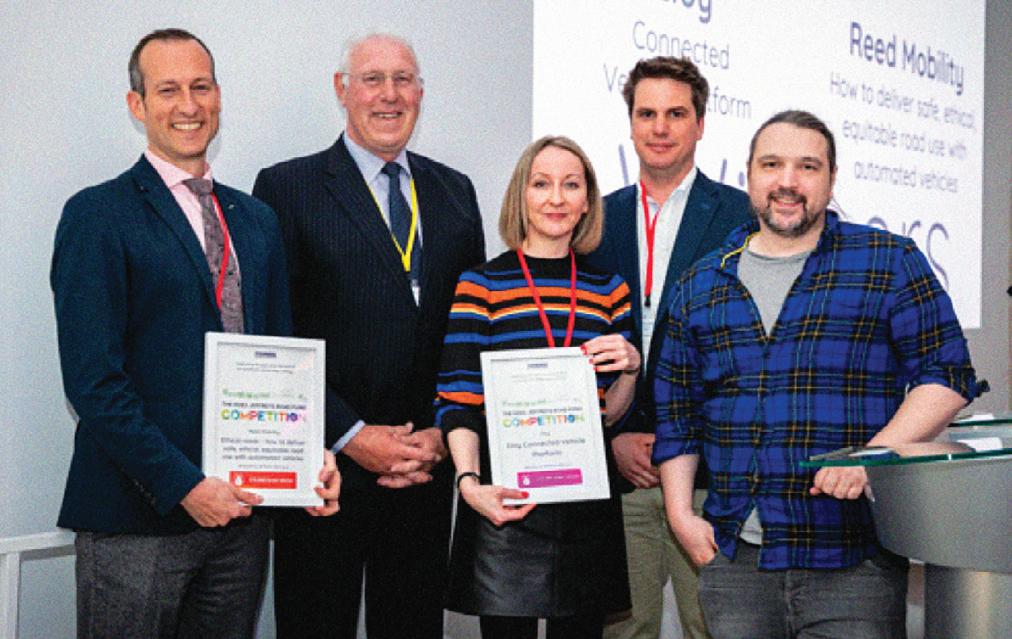
EasyPark Group, the parent of cashless payment service provider RingGo, has appointed a new chief executive officer.

Cameron Clayton, previously chief executive of The Weather Company, will take over the role as chief executive of the Swedish technology group on 19 April.
Clayton takes over from Johan Birgersson, who has led EasyPark for the past 14 years. Birgersson will continue as a senior advisor to Clayton and to the board of directors.

Birgersson said: “It has been an honour and a fantastic time in my life leading EasyPark Group, taking us from a Swedish start-up to where we are today, a global, market-leading tech company. Stepping down has not been an easy decision, but this role requires longterm planning. I have achieved my dream, to take EasyPark from the Nordics to over 20
BirgerssonEuropean countries and last year to the UK and across the Atlantic into the US.”
Niklas Savander, chairman of the board, said: “Johan’s devotion and track record in operational excellence is impressive. He has always led from the front and with his personal behaviour and decisions set the example for what good looks like and how values translate into action. This has made it possible for EasyPark Group to become a global pacesetter
connecting parking bays to drivers using the services of RingGo, JustPark, Connect and PayByPhone.

Kees Koolen, chief executive and founder of Koolen Industries, said: “ParkBee has an attractive and highly scalable business model. With its strong partners on both demand and supply, ParkBee is primed for rapid expansion throughout Europe.
within digital parking services.”
Cameron Clayton has a background in tech business and leading global organisations, most recently as chief executive of The Weather Company, a private weather forecaster. He was responsible for building weather.com into a top 10 website in the world, and also led the company to its partnership with Apple and Android, which made the Weather app the third most downloaded app in the world. In addition, he has been
general manager of IBM’s partner ecosystem, and he successfully helped lead IBM’s integration of Red Hat building Red Hat Marketplace.
Clayton said: “I am honoured by this opportunity to lead EasyPark Group going forward. The company has a great history and I am really impressed by the strong culture and commitment among all employees. With the acquisition of PARK NOW Group, EasyPark is well on its way to helping cities around the world be more liveable. I see a very bright future ahead and I look forward to being part of this journey.”
Board chairman Niklas Savander added: “The acquisition of PARK NOW Group from BMW Group and Daimler Mobility has enabled a great expansion of EasyPark Group’s global footprint. Cameron’s experience within business, product and technology strategy together with a strong ability to build high performing teams will be a great asset for the company.”

We currently supply and have vacancies around the UK for Permanent and Temporary positions:

• Civil Enforcement Officers
• Environmental Enforcement Officers
• Parking Back Office (Appeals/Notice Processing/Correspondence)
• Parking Change Management
Koolen Industries, a clean energy investor headed, has invested in ParkBee, a tech platform for offstreet parking in Europe.
Existing shareholders are Statkraft Ventures, Innovation Quarter, ParkBee management and employees. Total funding to ParkBee now amounts to €30m. The proceeds of the investment round will be put to work in supporting ParkBee’s expansion, both in existing markets and across Europe.
Currently, ParkBee is established in the Netherlands and the UK. and is rolling out in Germany, France, Belgium and Ireland. The company anticipates adding further countries in the near future.
In the UK, ParkBee’s technology acts as a parking platform,
“ParkBee’s dense network of garages offers great opportunities to further facilitate the transition to EVs in European cities. This transition is of key importance to the transition to clean energy in general, and also to the quality of people’s lives in our cities by both reducing noise and air pollution.”
WP Boerma, chief executive of ParkBee, said: “We are thrilled to secure such a reputable, experienced investor and tech entrepreneur as Kees Koolen. Coming from someone with such a record of picking winning tech platforms, we consider it a great thumbs up. I’d like to see this as recognition for the hard work and dedication of each and every one within ParkBee to get us where we are now. With the ‘rocket fuel’ now secured we all are looking forward to ParkBee at full thrust.”
• Interim Parking Managers
• Car Park Attendants/Marshalls/Stewarding
• Parking Supervisors (Both Enforcement and Back Office)
• Parking Management (Both Enforcement and Back Office)
• Heads of Parking/Directors
• Parking Technologies (Business Development and Project Managers/ Field Service Engineers/General Managers)
• Off Street Parking (Business Development, Contract Managers and Regional Managers)
• CCTV Operators – SIA and BTEC qualified
Looking for staff or need employment?
Please contact our experienced team on:

Tel: 0203 668 5680
Email: parking@unity-recruitment.co.uk

Web: www.unity-recruitment.co.uk







The British Parking Awards 2022 were launched with a splash of magic
This year marks the 20th anniversary of the British Parking Awards, so Parking Review will be celebrating the competition’s first two decades in style. The birthday journey began with the official awards launch party at the London Transport Museum in the heart of Covent Garden on 17 March. Over 175 parking people enjoyed an evening of magical entertainment, with guests being entertained by magicians as they explored the amazing exhibits at the world leading museum.
The evening’s master of ceremonies was John Mason, director of civil enforcement agency CDER Group, which co-hosted the social. Mason praised the assembled guests for their work supporting communities throughout the pandemic. “The parking sector has done a brilliant job during the lockdowns, with local authorities creating cycling and walking schemes, civil enforcement officers working in testing centres and civil enforcement agents delivering food parcels. So, after what has been a very tough two years, it has been a real pleasure to create an evening that allows you all to relax a little.”
Mason steered the audience through the programme, and also provided updates on the scoreline of his beloved West Ham’s Europa League game against Sevilla (The result was 2:0 to The Hammers).
The 2022 categories were unveiled by Paul Moorby OBE, chief executive of Chipside, the company behind the awards’ headline sponsor MiPermit. Inspired by the museum’s collection of vintage buses and classic trains, Moorby set parking in the broader context of innovative approaches to mobility. He observed: “Once we simply used to walk to work. Then, we hopped on a bike, took the train, caught the bus and then drove our cars, which all needed parking! Our sector is a key part of a story of progress, so never lose sight of how important freedom to travel is to ensuring our society remains a free and prosperous one.”
The attendees then received some handy insider’s advice on how to win an award from past trophy winners and current jury members John McArdle and Harry Clarke. The evening also saw the presentation of a special Lifetime Achievement Award to John Elliott, who over a career spanning almost 50 years has been a pioneer of using research and data to make the case for key policies such as civil parking enforcement and introducing green travel plans at workplaces.
The next stop for the British Parking Awards 2022 birthday bus will be the Royal Lancaster London on 16 September.

The competitive categories are assessed by the jury. The entries are published as a long list which is whittled down to a shortlist.
• Parking Person of the Year
• Rising Star Award
• The Front Line Award
• The Back Office Award
• Parking Team of the Year
• Parking Partnerships Award
• Parking Operator of the Year
• Parking Technology Award
• Communication Award
• Parking in the Community
• Outstanding Car Park Award
• Car Park Design Award
• Car Park Renovation Award
• Best New Car Park
The Rosettes are special awards reflecting big themes shaping the world of parking. These presentations provide some very special moments on the day.
• Reinventing the Street
• Parking for a Better World
• Parking Futures
The recipients will be selected by the jury from either the field of entries or drawn from the wider parking sector. There are no short lists, so the presentations will be surprises. The MiPermit Inspiration Award is the ceremony’s grand finalé.
• Special Jury Award
• Lifetime Achievement Award
• MiPermit Inspiration Award
The category criteria can be found on the official website: www.britishparkingawards.co.uk











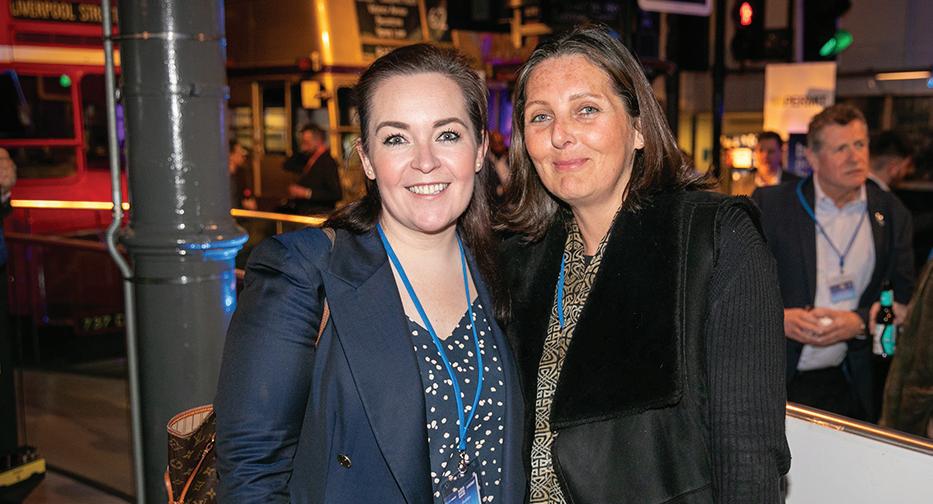

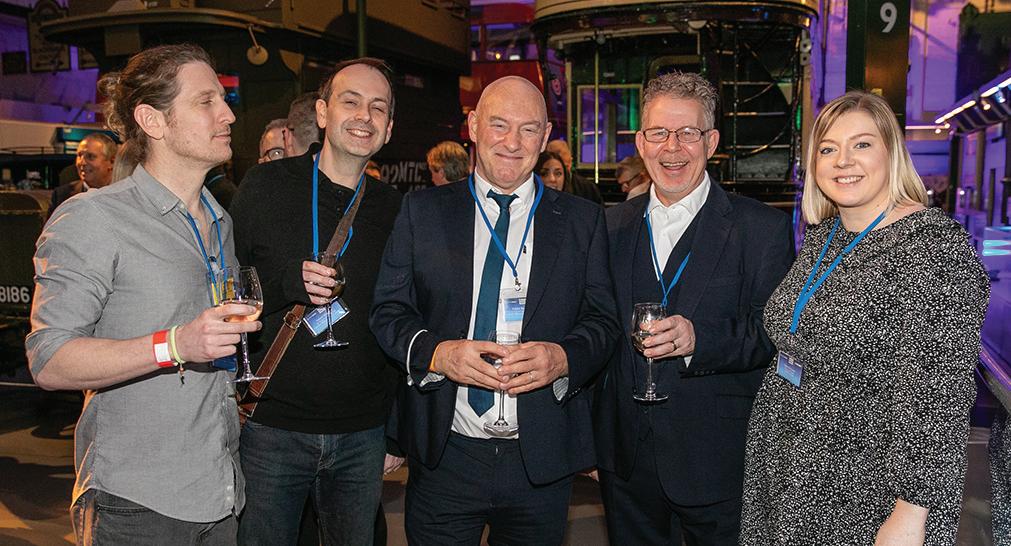






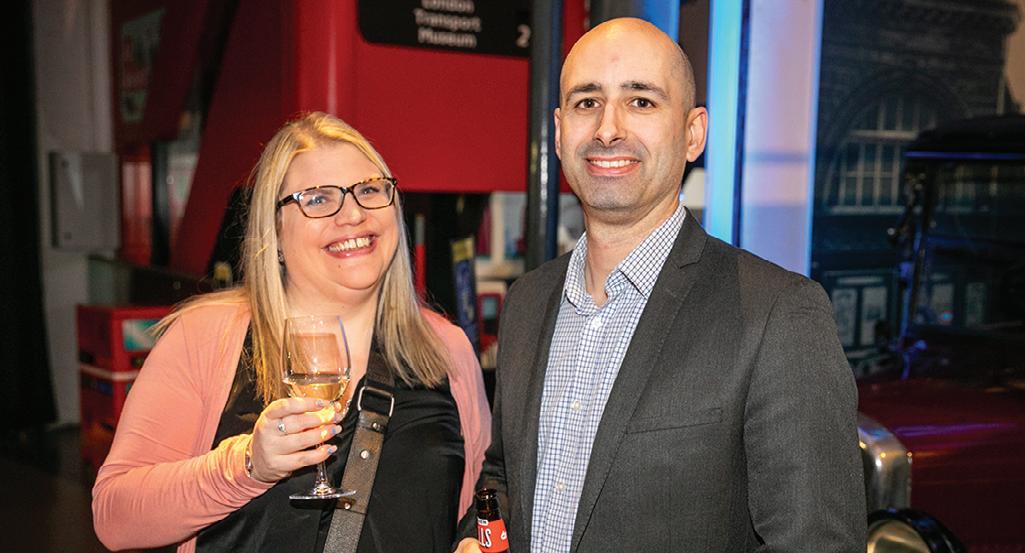

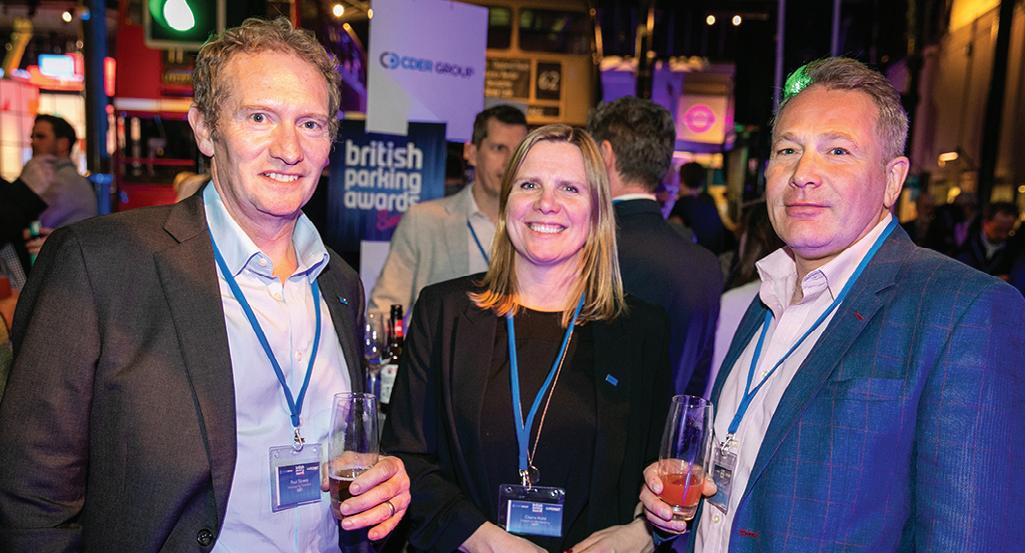
The British Parking Awards are rightly regarded as the ‘Parking Oscars’, so I want to begin by making the point that whilst I was hugely honoured by each of the four awards that my various winning entries secured over the years, I have genuinely found it a higher honour in recent years to be a judge.
Just as you would hope, the assembled judging table has centuries of parking experience. Sharp-minded individuals who literally go back to the dawn of decriminalisation and who, collectively, have created the industry that we see today. And we are led by Mark Moran who, let us not ever forget, has devoted his life to analysing and presenting the actions and initiatives of our industry and, terrifyingly, has an encyclopaedic memory of it all!
What is most striking though about we disparate dinosaurs is our collective clear sense and passion for how our industry should be delivering our service in 2022. And the standards that it needs to hit. Address either one of those, better still both, and you are onto a winner.
But beyond that, I think there are five tips I would share:
Each category has detailed descriptions of what an entry should address. Use them. You don’t have to, but you could do a lot worse than structuring your entry exactly under headings taken directly taken from the category description. It makes it easy for us judges to allocate points. And points make prizes.
Write about one thing well. We regularly get entries that seem to just describe a load of things the company has done that year in the hope that the panel likes some of it and can somehow make it relevant to the category headings. Often there is, indeed, a pearl somewhere on the smorgasbord that could have been developed into a winner but it is lost and devalued by this ‘throw stuff at a wall’ approach. Entries like that don’t win prizes.
Write or re-write your entry specifically for these awards: because you are up against some fierce competition. Some entrants spend thousands of pounds on outside agencies to write, design and illustrate their entries, often with professional supporting videos. But rest assured that we can see beyond all that and are interested in the substance of the entry not the wrapping. Equally though, there are some fundamentals such as: accurate spelling, freedom
Parking Review editor Mark Moran is looking forward to another British Parking Awards season
The British Parking Awards came into being in 2002 as a way for Parking Review magazine to showcase innovative technologies and best practice in the design and management of parking.
When the inaugural competition’s winners were revealed at the Tower Thistle overlooking the River Thames two things struck me. Firstly, even though the awards had not existed before, winning them really mattered to the attendees. The fact the competition was judged by an independent panel was a key factor. The other thing that became apparent was how the attendees really, really enjoyed having a Friday afternoon socialising with colleagues and peers.
So, ever since then, we have run a competition that is rigorously judged by an independent minded jury and worked to make the awards ceremony and lunch the highlight of the sector’s social calendar.
The 2022 competition launch event at the London Transport Museum was a brilliant curtain-raiser for what I hope will be best British Parking Awards ever.


from typos, clear layout and helpful use of pictures that will boost your chances a lot if you apply this basic level of polish. And here I would suggest that good entries appear to me to always be team efforts, with a passionate author supported by colleagues who can give the basic entry both a thorough editorial review and a sprinkle with the stardust of layout and design.
Figures that show usage or growth are helpful. Tell us where your innovation has been deployed. If the local press featured it in an article, good or bad, include it as an appendix. Show us, in some way or other that it really happened, even if it is a “vox pop” video of your own granny saying something nice about it. In short –answer our question: Is rubber hitting the road?
May I suggest a nice title page with a picture? Page 2 should then be a single page management summary. These two things are, for want of better words, teasing us with some intellectual foreplay. Then follow up with the main event: what the problem was, how it was solved and evidence of why the solution was successful. Then perhaps write a short and clear conclusion stating immodestly why you think this should win an award in 2022. A total of 10 pages tops, and ideally six or eight.
In summary, the judging panel loves our work and we delight in attending the event and seeing worthy winners with big smiles on their faces having won the ultimate accolade our industry can offer. We all want you to win. Help us help you and, on behalf of all the judges, let me wish you all the very best.
Harry Clarke is director of Arlander and was co-founder of RingGoParking technology pioneer Harry Clarke offers some advice on what the British Parking Awards jury is looking for when judging entriesHarry Clarke Mark Moran
John Elliott has spent 50 years pioneering new perspectives on parking management and sustainable transport planning

During a very distinguished career, John Elliott, who has worked in the traffic and parking sector for over 50 years, has been a pioneer of effective traffic and parking management, as well as an early advocate of green travel plans. Elliott started his working life as an aeronautics engineer but swapped the conquering of the skies for sorting out the streets in 1971. Since then he has undertaken key transport planning and operational roles within local authorities, universities, civil engineering and planning consultancies, industrial companies, facilities management and parking management operators.
Elliott was chief traffic engineer for Westminster City Council. In 1979, he presented a policy paper with Nick Bursey of Colin Buchanan & Partners on a policy paper that explored the use of parking controls as a method of traffic restraint in London. This influential publication, together with extensive analysis carried out by Elliott and others helped, helped lay the ground for civil parking enforcement.
His public sector posts have also included a stint as head of policy and project assessment for the Greater London Council (GLC), as well as becoming deputy borough engineer, surveyor and planning officer for the London Borough of Barking and Dagenham and director of technical services and planning for Aylesbury Vale District Council. In the private sector his roles included being head of traffic and parking at Sterling Security and later director of parking for Legion Group.
He was also transport and planning manager for Pfizer, where he developed a sector-defining sustainable travel plan including the novel parking cash-out system that achieved significant change in company culture and major change in staff travel (a 20% reduction in car use in two-and-a-half years). Pfizer’s experience provided a model reflected in many other travel plan
guides. He also achieved large changes in staff travel for Canterbury Christ Church University, where he was sustainable transport manager, and also for the London Borough of Southwark.
Elliott is a Chartered Civil Engineer, Fellow of the Chartered Institution of Highways and Transportation, a Member of the Institution of Civil Engineers and the Chartered Management Institute. Elliott is now an independent transport consultant and a part-time lecturer at the University of Hertfordshire and an independent consultant. He also finds time to be a special adviser to the the National Transport Committee of Local Government Technical Advisers Group (LGTAG).
Mark Moran, editor of Parking Review, said: “John is one of the most insightful, perceptive and compassionate people I have ever met, both in the world of parking and everyday life. He is also perhaps the politest person in parking. It is an honour for the British Parking Awards to recognise such a brilliant career.”

Partnership working and sharing good data are essential to protecting the integrity of traffic and parking regulations, reports Mark Moran
The Persistent Evaders & Nuisance Vehicles Summit was held at the London Transport Museum on 17 March. The Parking Review event explored the problem of drivers who flout motoring laws and repeatedly avoid paying their debts.


An expert panel discussed how people who avoid paying a Vehicle Excise Duty (VED) are also likely to drive an uninsured car without an MOT, use fake permits and owe a backlog of unpaid penalty notices. Besides being in themselves dangerous, the vehicles these anti-social evaders drive are often associated with criminal activity. Worryingly, the problem of nuisance vehicles is growing as persistent evaders are seeking ways to avoid paying charges related to Clean Air Zones, river crossings and moving traffic regulations.
The good news that emerged is that new techniques make it possible to identify and tackle persistent evaders, to remove nuisance vehicles from roads and recover unpaid penalties. Civil enforcement agencies are working with local authorities, highways authorities and police forces while also leading a debate to ensure the issue is recognised at a national policy level.
To assist this work, the event’s chair John Mason, director for road traffic and road user charging services at CDER Group, made an impassioned plea for an overhaul of the way in which DVLA functions in order to get more accurate vehicle keeper data to make it easier to locate persistent evaders (see page 32).
Alan Wood, strategic account director of Just, stressed the importance of partnership working and of getting the support of the police and central government when tacking nuisance vehicles (see opposite page).
Paul Cowperthwaite, general manager, road user charging at Transport for London, outlined how data is being leveraged to measure and counter abuse of the Congestion Charge and Ultra Low Emission Zone. He also revealed how County Court Judgments can be a powerful tool to tackle persistent evaders.

Art Mitchells-Urwin, counter-fraud business development and operations manager at the Cabinet Office, explained how the Digital Economy Act enables public authorities and other organisations to work together to manage and reduce debt and also combat fraud using each other’s data.

The integrity of number plates is integral to camera-enforced traffic management schemes such as Clean Air Zones, which have so far been introduced in Birmingham, Bath and Portsmouth, with schemes due to start in Bradford, Bristol, Newcastle and Sheffield later this year, as well as London’s Ultra Low Emission Zone (ULEZ), which was extended in February. There will be a group of motorists who seek to evade payment of clean air fees, adopting tactics such as using cloned number plates – number plate cloning, also known as car cloning or vehicle identity theft, is when someone copies a car’s registration number and illegally displays it on another vehicle.
Using a cloned plate is risky, as it is a criminal offence. The fines for using a cloned plate can be as high as £1,000. But before a penalty can be issued, the fraud needs to be detected. A pair of experts who are researching the problem of nuisance vehicles argue that this criminal activity can best be tackled through police forces, local authorities and enforcement agents working more collaboratively to share data intelligence.
Former senior police officer Tim Ashman, director at TJA Associates, and Alan Wood, strategic account director at civil enforcement agency Just, are leading work on tackling nuisance vehicles at a national level. Identifying cloned vehicles represents one aspect of a wider crackdown on persistent evaders, who often are also non-compliant in a number of other ways such as insurance, MOT, Vehicle Excise Duty and/or failing to register the vehicle’s keeper.
Ashman and Wood are advocates of multiagency working and the sharing of data and intelligence. Piecing together evidence from multiple sources about a persistent evader’s vehicle – including insurance and unpaid parking and moving traffic penalty charge notices (PCNs) – can reveal their identity, they said. There is growing evidence that vehicles with multiple unpaid PCNs are more likely to have no insurance, excise duty or MOT.
“A significant information advantage can be created by blending vehicle use data from multiple sources,” said Ashman. “We are seeing huge potential for this approach in tackling the problem.”
Wood added: “What we are finding is that the drivers of these vehicles are more likely to behave in a criminal way, which is going to impact on other people.”
Ashman and Wood recently worked with a “rural country council and constabulary” to explore the links between various types of offending vehicle-use behaviour. Taking the council’s top 40 persistent parking offenders (unpaid PCNs), subsequent checks revealed that 60% had no Vehicle Excise Duty, 23% had no valid MOT, 33% had no insurance and 53% had no current keeper registered with DVLA. “Of the 40, just three were lawful vehicles with solely parking contraventions,” said Wood. “If this is the case in a quiet, low crime rural area what would we find in the capital?”
Ashman said: “This illustrates the value in looking at the totality of the way a vehicle is being used, rather than just in isolation about its parking history. These multiple checks are
Alan Wood has been campaigning to raise awareness of the extent and impact of nuisance vehicles for several years. The civil enforcement specialist believes tackling nuisance vehicles can improve road safety, recover funds owed to local authorities, reduce anti-social behaviour and deny criminals the use of the road, Working in partnership with local authority clients, Wood has conducted a series of initiatives that have provided a new understanding the extent of the problem of vehicles without valid tax and that have no insurance or an MOT.
important because without them, there is chance that we deal with a less serious offence and miss something more serious.”
In a separate research project, last year the pair examined the relationship between the speed a vehicle is driven and other offending driver behaviour. Studying a stretch of road with average speed cameras, they concluded that the higher the speed that vehicles travelled above the speed limit (50mph in this instance), the greater the number of other offences were related to that vehicle.
At the Persistent Evaders and Nuisance Vehicles Summit, Wood said: “It is clear that the increase in camera enforcement will inevitably increase camera evasion and we need to have the tools to tackle this or we will lose control of our vehicle community.

“What we need is some kind of devolved road safety agency which can go into a community and work directly with local government and the police. By stopping persistent evaders and removing their vehicles from the road we can disrupt criminal activity. We must start working together!”
With the support of the British Parking Association (BPA), Wood has driven the creation of a national working group on persistent evaders and nuisance vehicles. An initial meeting in 2020 was attended by the Department for Transport (DfT), Driver and Vehicle Standards Agency (DVSA), Highways England, National Police Chiefs Council.
This discussion led to an unanimous agreement that vehicle non-compliance was an increasing issue. It was agreed a working group should be put together made up of the DfT, DVSA, Highways England, National Roads Policing and BPA, as well as representatives from the Driver and Vehicle Licensing Agency (DVLA) and Transport for London (TfL).
The Nuisance Vehicle Working Group wants to investigate scenarios facing local authorities when it comes to managing vehicle communities to establish what powers currently exist and how those powers can be devolved councils.
During 2021 the working group agreed to look at two key areas: persistent evaders and the powers currently available and what needs to be done to make those powers workable; and identifying vehicles without a valid MOT. Work on pilot schemes is now underway.
cloning is a growing problem warn enforcement experts Alan Wood and Tim Ashman. Deniz Huseyin reports
We need a devolved road safety agency which can go into a community and work directly with local government and the police Alan Wood

What is a persistent evader? A vehicle owner can be classed as a ‘persistent evader’ if there are three or more recorded contraventions for the vehicle and the penalties for these have not been paid, represented against or appealed against within the statutory time limits, or their representations and appeals have been rejected but they have still not been paid.
CDER Group has developed two in-house definitions to help us deal with repeat offenders. A ‘persistent offender’ is a term we use for those who continually end up in the enforcement process because they have not paid a parking penalty or road user charge. But these generally pay as a result of our enforcement actions. These are perhaps regarded as the “rich and forgetful” people.
We define a ‘persistent evader’ as a debtor with three or more outstanding live warrants for the debtor where there has been no payment. It is the persistent evaders who are causing an increase in the need for the use of civil enforcement to collect unpaid charges. The problem is going to get worse because regulation of the highway is increasing. In the past five years there has been a significant increase in the use of civil enforcement through the implementation of new road charging schemes such as the Dart Charge and Mersey Gateway, as well as the expansion of bus lane and moving traffic enforcement. Looking ahead, we will see schemes such as Clean Air Zones and road user charging using automatic number plate recognition (ANPR) to collect charges against a registered number plate.
There are two other groups that it is worth noting:
Hire and lease companies: The likes of Alphabet, Hertz, Northgate Vehicle Hire and Enterprise have thousands vehicles
and these commit thousands of contraventions every day. But these companies generally transfer liability to the driver or pay when engaged with by civil enforcement agencies.
Vulnerable people: We frequently encounter vulnerable customers who “own” the vehicle but are not the cause or person responsible for the contraventions committed. These vulnerable people live at an address through which a persistent evader has registered the nuisance vehicle. This is the sort of tactic used by unscrupulous individuals to avoid receiving penalties and correspondence. We need to keep such scenarios in mind when we talk about developing solutions for the persistent evader problem.
So what is the impact now and going forward? Well, clearly there is loss of penalty charge notice (PCN) revenue to local authorities as a result of persistent evaders. I know not many people will get their violins out because of uncollected council debt or the loss of revenue incurred by civil enforcement agents. But unpaid debts amount to a cost to society, to each and every one of us.
When pursuing unpaid PCNs, civil enforcement agencies and our clients incur the cost of following the statutory processes. The reality is that sometimes we spend a huge amount of time chasing down persistent evaders and do not get anywhere.
To better understand the costs involved, CDER undertook an
• Lost PCN revenue due to local authorities and government
• Unrecovered Traffic Enforcement Centre (TEC) fee costs
• Lost revenue to debt recovery providers
• Cost of following standard statutory recovery process
• Impact of unproductive enforcement agent visits
• Wider impact of link between persistent evaders and nuisance vehicles, uninsured and untaxed vehicles.
analysis of the top 200 persistent evaders in the road traffic and road user charging space across all of our clients. These 200 persistent evaders have generated an astonishing 58,962 cases. Some 285 warrants were issued the top persistent evader. All those cases generated £530,000 in TEC (Traffic Enforcement Centre) fees, which are required to make the debts actionable.
We have invested much time and money in engaging with these 200 repeat offenders.
We have sent them 72,012 letters.
We have sent them 34,671 SMS messages.
We have carried out 6,200 visits.
All of those cases account for £9.8m worth of debt.
Yet, despite all the work done on trying to engage with these 200 persistent evaders we have not received a single penny. None of our activity has generated a single penny that I have been able to pass back to my clients, not one penny of fees that I can use to offset the cost of pursuing this position.
I hope that helps puts the challenge the traffic and parking sector faces into perspective.
There is clear evidence that some persistent evaders are using cloned number plates, which is a risky thing to do because if you get caught with a faked number plate that is a criminal matter.
But I believe the single biggest root cause of persistent evasion in England and Wales and Scotland is the DVLA and DVLA’s data. It is far too easy to “opt out” of the vehicle keeper database. One call or letter is all it takes to obtain a letter from the DVLA that you are not the keeper of a vehicle. The level of DVLA “No keeper details” in response to queries by authorities and enforcement agencies continues to increase and ranges between 10-20% based on client estimates.
The disconnect between vehicle and driver licensing database is a real problem, as is the ability to register false information and non-drivers such as children.
Thus, it is my belief the driver and vehicle licencing process, and the current regulations, are not fit for purpose. There are flaws in the policies and procedures that exist and a systematic failure by the DVLA to correctly record or enforce. Then there is DVLA’s inability to provide accurate or even any vehicle keeper details. DVLA was sent an Freedom of Information (FOI) request asking for the number of requests where name and address was provided and DVLA did not or was unable to provide name and/or address of the keeper in response to the requests.
The agency’s answer was that this information is not held by DVLA. It wrote: “While the DVLA knows the number of requests made via the WEE [Web Enabled Enquiry] and KADOE [Keeper At Date Of Event] services, the process is an electronic one which returns an appropriate response (i.e. keeper data or no keeper data held) in each case. Therefore requests are neither declined nor refused. There is no business need for DVLA to record separately what information was returned to the local authority. DVLA has a process in place to audit local authorities who make requests electronically via the WEE and KADOE services.”
When the DVLA states “there is no business need” it is saying that the data is not collected because it has no direct impact on the DVLA’s performance targets, revenue or objectives. It does not matter. Who cares? It is apparent that there is no pressure on DVLA whatsoever. The issues we face have no impact on them.
The lack of meaningful enforcement by the DVLA for driver
and vehicle licensing offences other than untaxed vehicles is a pressing issue. The agency does not look for or take action against vehicles without tax or lacking an MOT. DVLA has got the resources on-street, but when driving down a road its vehicles could pass six or seven cars where they do not know who the register keeper is, but they will clamp the one that was untaxed. I could be going down the street and using those resources!
And it is all too clear that the current regulations do not support the notion of continuous registration of a vehicle.
So, how do we solve these problems? I suggest that this can be done by addressing the issues in two time frames: one immediate and one with a longer perspective.
In the immediate and near term there are number of things that can be done by local authorities and their civil enforcement agency partners, including:
• limit progression of cases through TEC until enforcement provider establishes contact/obtains payment
• utilise third party data sources to validate DVLA data pre-TEC
• active and dynamic links between on-street civil enforcement officers (CEOs) and enforcement agents to prioritise vehicle immobilisation and removal
• early identification of persistent evaders to engage alternative legal options.
The short-term solutions are ones that those working in the traffic and parking sector can deliver, but in the longer term the persistent evader problem will never be resolved without fundamental changes to the vehicle keeper licensing system and the DVLA being held to account. We can all raise the awareness of the financial and wider impacts of missing and incorrect DVLA data with government and decision-makers.

We need to demand a clear, strategic plan for improving the completeness and accuracy of the vehicle licensing database. This plan must be backed up by consistent and effective enforcement to at least the same level as untaxed vehicle: No keeper data means clamp and removal until a keeper is identified and recorded.
So in the long term, let’s get the government to undertake a proper review of the regulations. Let’s work together to get a fitfor-purpose continuous licencing system, because without these changes this persistent evader problem is not going to go away.
John Mason is CDER Group’s board member lead for parking, traffic and road user charging contracts. He has over 27 years parking, traffic and road user charging enforcement industry experience. His was responsible for the City of Westminster’s vehicle removal operation and was director of Transport for London congestion charging and traffic enforcement. Mason is also an executive member of CIVEA, the civil enforcement agency association. www.cdergroup.co.uk
Unpaid PCN debts amount to a cost to society, to each and everyone of us John Mason
Multi-storey provides over 400 parking spaces for passengers
A new multi-storey car park has opened at Bishop’s Stortford railway station in Hertfordshire.
The car park on Anchor Street offers parking for 401 cars and features 14 electric vehicle chargepoints.
There are 20 Blue Badge spaces, all on the ground floor, two of which are supplied with EV charging points.
There is also a secure cycle compound with 50 spaces.
The car park – which is split over 11 floors and has two lifts – has power doors and is fully wheelchair accessible.

Initially, people will be able to park between the ground floor and level 9, with the final two floors being open for use at a later date.
Designed and built by Goldbeck Construction, the project was built for Solum
Regeneration, which is a partnership organisation between KIER and Network Rail.
The car park structure consists of prefabricated steel elements that make-up the superstructure, and prefabricated concrete slabs that form the driving aisles and parking bays on each level. Two ramps on each level allow easy access between levels and ensure uncongested circulation.
Transport secretary Grant Shapps has stepped in to block Transport for London (TfL) plans for 351 new homes at Cockfosters Underground station in Enfield because the development would cut parking at the station from 370 spaces to just 47 bays.
The 40% affordable home scheme, including four tower blocks up to 14 storeys, was approved by Enfield’s planning committee in February with the casting vote of committee chair Sinan Boztas.

However, the project had faced opposition from residents, local Labour MP Bambos Charalambous and Chipping Barnet’s Conservative MP Theresa Villiers, who had argued that the extensive car park around the Grade II-listed station at the end of the Piccadilly Line performed an “important park & ride function”.
Shapps confirmed in a letter to Villiers that he had used veto powers under the GLA Act 1999, the legislation which created devolved government in the capital. Shapps wrote: “I am concerned that the parking provision at the station would be inadequate following the development proposed by TfL”.
TfL said it is not aware of any previous instances where the
Secretary of State has used this particular power. A TfL spokesperson said: “We can confirm that on 25 February we received the decision from the Secretary of State. We are now taking the necessary time to understand and consider the implications and available next steps that result from the decision.”
The development was the fifth brought forward by TfL’s Connected Living London (CLL) partnership with build-to-rent specialists Grainger, established in 2019 with a focus on “brownfield” sites by Tube stations, including car parks.
While the Cockfosters scheme attracted 2,852 objections, it also drew support from transport campaigners and from the Enfield Society, which told the council that the station car park was a poor use of space and residential development on brownfield sites was appropriate to help meet borough housing targets.
The site is adjacent to the railway station, a bus interchange, railway sidings, as well as residential, commercial and industrial properties.
This has led to the car park being given multiple facade elements. The west side consists of Corten steel perforated panels with a randomised windowshaped hole pattern to disguise the appearance of the multi-
storey car park. The east side, on the other hand, has been cladded in concrete panels and cream coloured brick cladding designed to blend the structure in with the surroundings.
Finally, the north elevation was rounded off with a band of darker brick cladding that acts as a complementary finish to the white.
Simone Bailey, Greater Anglia’s asset management director, said: “Working with our rail industry partners, underutilised land has been released for comprehensive redevelopment – enabling Greater Anglia to provide a brand-new, fit-for-purpose, multi storey car park for the benefit of our rail customers and the town centre.
“We know many of our customers are environmentally conscious, and we are pleased that the car park includes a secure cycle compound and 14 electric vehicle charge points – currently the highest number at any station on our network.”
West Yorkshire Combined Authority and train operator Northern are to build a new multi-storey car park at Steeton and Silsden railwaystation.
The car park is designed to increase parking provision, improve overall accessibility and encourage rail use. The project is one of 14 projects within the combined authority’s £31.5m rail park & ride programme.
As part of improvements, an additional 102 car parking spaces will be created, taking the total available spaces to 245. The start date is planned for early April.
Parking will be free to rail users. There will be nine Blue Badge bays, helping make the station a far better option for passengers requiring enhanced support.
The car park will feature CCTV facilities and LED lighting for user safety and comfort. A fully accessible lift will make access to and through the car park and station easier.
The car park will also benefit from improved drainage infrastructure, to improve the local environment and the safety of the locality.
Mayor of West Yorkshire Tracy Brabin said: “As a
passionate advocate of rail travel and a commuter myself, I understand the frustration commuters have felt due to the slow progress on the Steeton and Silsden railway station car park. I can appreciate, however, that improvements like this one can sometimes be met with significant obstacles and problems. I am, however, very pleased to be able to tell the people who use Steeton and Silsden railway station that we can now start the important improvements to parking at this station.”
Building the new car park requires closing the existing main car park during construction, which is expected to last 12 months. A portion of the overflow car park will remain open to station visitors, with around 40 spaces available. As there will be limited parking availability throughout the construction period, station users are being advised to consider alternative arrangements and, where possible, to walk or cycle to the station.
Maps can be found via the combined authority’s website on alternative local car parking facilities along the Airedale line.

Car park will serve Lancashire resort’s heritage quarter
The Blackpool Central leisure development will feature a brand new multi-storey car park capable of accommodating over 1,400 vehicles.
The project is being built on the former Central Station site, just off the Lancashire resort’s famous Golden Mile.
Central Station closed in 1964 and has since been used as a car park. Previous attempts to develop the site, including planning applications in 2001 and 2006 had failed.
The latest £300m scheme will be the largest single investment in Blackpool for over a century, It is expected to create around 1,000 new jobs, bring an estimated 600,000 additional visitors each year, and boost annual spend in the town by around £75m.
Developers Nikal and Media Invest Entertainment will oversee the project, which features a new 1,306 space multi-storey car park on Seasiders Way and a new heritage quarter.

CGI rendering of the new car park
Nikal has selected
a public events square for live events, three indoor entertainment centres, hotel, restaurants, and leisure and hospitality space.
Cllr Lynn Williams, leader of Blackpool Council, said: “This is a really significant development for Blackpool and although everyone are all really keen to see works start on site, the council and the developer Nikal, want to get it right from the start.
“It is a main route into the town centre for our visitors and we want to ensure that the diversion routes work well for everyone involved over this prolonged period of works.”
Nedam
build the car park. Construction of the multi-storey will take around 16 months to complete
The heritage quarter is set to be built by spring 2024, with further phases not operational until spring or summer 2025, and the full development expected to take 10 years to complete.
The planning application for Blackpool Central proposes to restore the site’s existing heritage buildings to create a new heritage quarter.
The Grade II Listed former King Edward VII Picture House will be transformed into a new ‘Artisan Food Hall’, which spills out onto a new outdoor space for ‘al fresco’ dining.
The locally listed King Edward VII pub will be refurbished into a new pub and hotel, creating a modern, family-friendly environment offering quality food and beverages.
The King Edward VII apartment building will be renovated into a high-quality ‘aparthotel’ keeping its original character.
Plans for future phases feature
Richard Fee, chief executive officer at Nikal, said: “This is an important step forward and builds momentum behind Blackpool Central. We look forward to breaking ground on this crucial first phase, which will kickstart one of the UK’s most important regeneration projects.”
With construction work set to start after Easter, spaces on the existing Central car park will be reduced as the contractors continue to fence off parts of the car park as per their programme of works. Other car parks in the area remain unaffected.
The International Parking Community is to mark its tenth anniversary by staging a charity gala and dinner for companies and organisations in all areas of the UK parking industry. Comedian Justin Moorhouse will compere the event, which will be held at the Midland Hotel in Manchester on Thursday 24 November 2022.
All money raised will be used to support Alder Hey Children’s Hospital in Liverpool and Made with Hope, a charity that provides sustainable education facilities and support for children in deprived areas of Tanzania.
“Parkex and the British Parking Awards are wonderful events for the everyone in parking,” says Will Hurley, chief executive of the IPC. “But there has never been a major industry event to provide all parking organisations with the opportunity to make a real difference for those in real need. We want to change that.
“We have always had a charity fundraising drive after our annual conference that has been a fun and entertaining evening for IPC members and their partners, and have previously raised well over £55,000 for a number of wonderful charities. This year, however, we’re going much further by increasing the scale and stature of the event and opening the door to any company in any sector of the parking industry.
“I’m delighted St James’s Place has con-
firmed it will match fund pound for pound all of the money we raise on the night for the foundation’s charities. It promises to be quite an occasion and will be the biggest charity event ever held by the parking industry.”
The charity event will feature an evening of fine dining, entertainment and fundraising initiatives hosted by stand-up comedian, radio presenter and actor Justin Moorhouse.
First achieving recognition for his role in the Peter Kay sitcom Phoenix Nights, Moorhouse is a familiar face and voice on TV and radio and was a previous winner of BBC’s Celebrity Mastermind where his chosen specialist subject was Les Dawson. He will touring the UK during 2022 with his Stretch and Think show.

Although separate events, both the IPC’s 2022 annual conference and the Charity Gala event are being held at the Midland Hotel in Manchester on 24 November. The main focus of the annual conference will be the implementation of the government’s new code of practice for the private parking sector, as well as sessions for the local authority, health and higher education sectors.
www.ipcconference.co.uk
The British Parking Association (BPA) staged a 50th anniversary party at the Dorchester in London on 24 March. The black tie event was attended by parking professionals from across the public and private sector, and saw a gathering of many past presidents and members of the association.
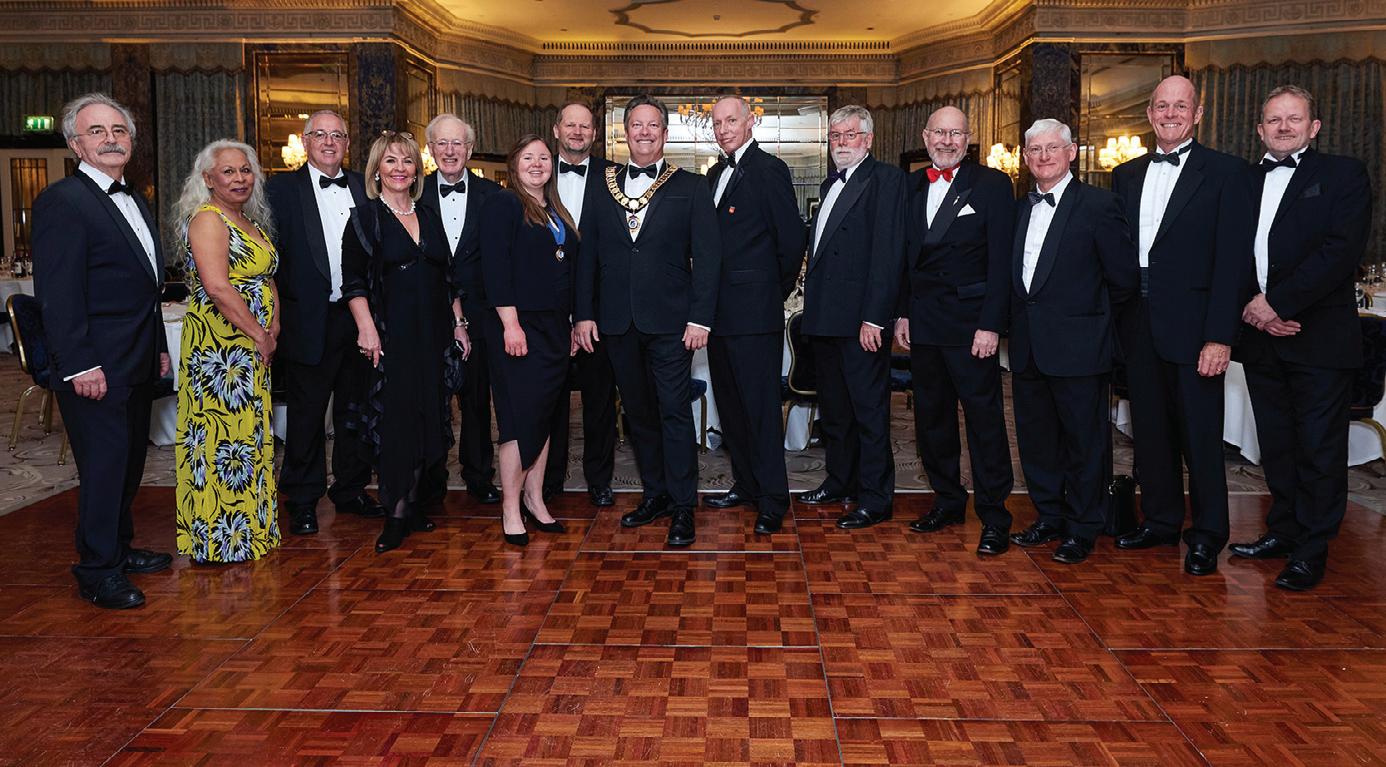
BPA president Mike Marrs told guests: “Our amazing membership community has shown a tremendous ability to evolve and support each other when the going gets tough. We should all be very proud. The BPA is more vibrant and relevant than ever.
“I want to recognise the incredible efforts of our council, board and staff team. Despite significant challenges, our
association continues to evolve and innovate and remains perfectly placed for the next 50 years.”

Looking to the future, BPA chief executive Andrew Pester said: “We are working with our board and council members to develop a new strategic plan for the future which will further enhance our agile response to change and relevance in all that we do, underlining our commitment to innovation, offering more on-line services to members, and further improving member engagement. This will set the foundations for further transformation and help our modern association continue our journey towards an increasingly digital native future.”
Stuart Harrison, chief strategy officer at UK Parking Control (UKPC), has been named as the British Parking Association’s next vice president.
Harrison has worked in the parking sector since 2009 and been actively involved with the association since 2015, serving on its council and the operational service board. Most recently, he has been involved with groups such as Park Active and Women in Parking.

He will be supporting Jade Neville, Conduent’s head of user experience, when she steps up from being vice president to become president.
Neville and Harrison will take up their roles at the association’s annual general meeting July. The current BPA president is Mike Marrs, business development director at Marston Holdings.

Drivers say they are being left feeling bemused and bewildered when using a south London council car park that offers 130 different pricing options. The rates at the Lewisham Council car park are designed to reflect how much CO2 a car emits.

The tariffs are presented as a grid of fees ranging from 38p for a 15-minute stay to £38.75 for more than six hours. Motorists calculate the cost of parking based on their car’s Euro 6 emissions standards, along with which tax band their vehicle falls into and the length of their stay.
The pricing strategy was highlighted by broadcaster Danny Baker, who tweeted a picture of a sign of the tariffs at a car park in Blackheath, south-east London. Baker told his followers: “Went to park up today in the same little car park I’ve used near me for 25 years. Excited to see the council have introduced a streamlined E-Z new pay system that in no way suggests they have too much time on their hands these days.”
Several followers echoed the thoughts of the comedy writer and presenter.
@GrahamCope1 tweeted: “Well that’s clear as mud. Seriously, who knows the grading of their own car as suggested?”
@africanhopkins said: “I bet the area is full of Band 1, Euro 6 compliant vehicles. Whatever they are. Probably skateboards.”
Others have tweeted that they were unsure why cars should be charged more based on their emission levels when their engines are not on while they are parked.
Responding to the tweets, Lewisham councillor Patrick Codd said the aim of the scheme is to encourage more people to walk, cycle and use public transport to cut vehicle emissions. “The introduction of short-stay emissions-based parking means all our parking charges will be based on levels of pollution from vehicles,” he said.
European emissions standards were first introduced in 1993 with Euro 1 requirements set out for reducing the environmental impact of new cars. The latest standard is Euro 6, and new cars must meet this before they go on sale in Europe. Euro 7 standards could come into force in 2025. Vehicles that meet Euro 6 standards are charged much lower tax rates than those emitting more CO2 per kilometre.
Drivers are confused by rules on streets around Royal Botanic Garden that mean it can cost twice as much to park on different sides of the road.
On Arboretum Place drivers are charged £6.50 to park for six hours on part of the street, but could pay £15 when parked for the same length of time along other sections.

On one side it is possible to park for up to six hours, at a cost of £2.50 an hour. On the opposite side there are sections where the charges are £1 for up to one hour, £2 for two hours and then £6.50 for up to nine hours. However, there are also parts of that side where the six-hour rules applies, with the higher charges.
Around the corner on Inverleith Place two different sets of charges are also in force. There is a bus parking bay that charges £5.50 per hour, up to a maximum of 10 hours. However, on the other side there is a four-hour parking bay which charges £2.50 an hour. But, the nearest parking machine is on the same side as the bus parking bay, which dispenses tickets costing £5.50 an hour.
One driver told BBC Scotland that he ended up with a fine
because the parking charges were so confusing in the streets around the city’s Royal Botanic Garden. Iain Robertson was issued with a fine after parking in Arboretum Place while visiting the garden with his wife. He said he paid at a parking machine on the opposite side of the street because the one on his side was busy. He later realised that he had parked in the six-hour section but had paid at the machine which issues tickets for the nine-hour parking bays.
Robertson said he had been very confused to discover a penalty charge notice when he returned to their car, so he questioned a passing parking officer. “He pointed out I must have paid at a machine on the
wrong side of the road and said a lot of people had complained,” said Robertson.
A council spokeswoman said: “As is the case on many streets across the city, there can be different types of parking bays, with different charging structures. There are signs indicating the relevant ticket machines and we would encourage drivers to check these when parking.”
Baker’s tweet

Almost a quarter of motorists give their car a name, according to research from GoCompare Car Insurance. The comparison website asked over 1,400 drivers if they named their car and 24% admitted that they do. This figure jumped to 43% when speaking to motorists aged between 18-24.
Some 40% of motorists from London said that they name their car, making it the region most likely to adopt a moniker for their motor, being over double the percentage for people who live in Scotland, where just 19% of motorists will give their car a name.
When asked about the actual names people give their cars Betty, Baby and Nellie top the list, with the top ten names people give to their cars being as follows:
Other





























